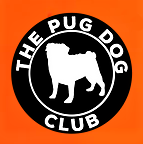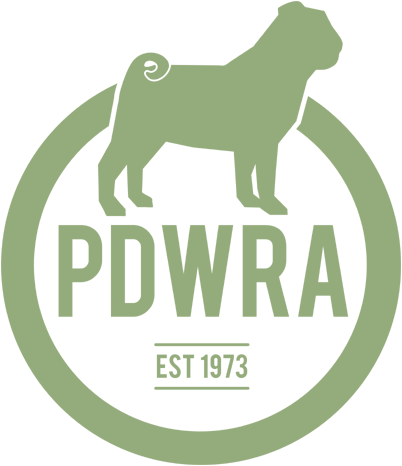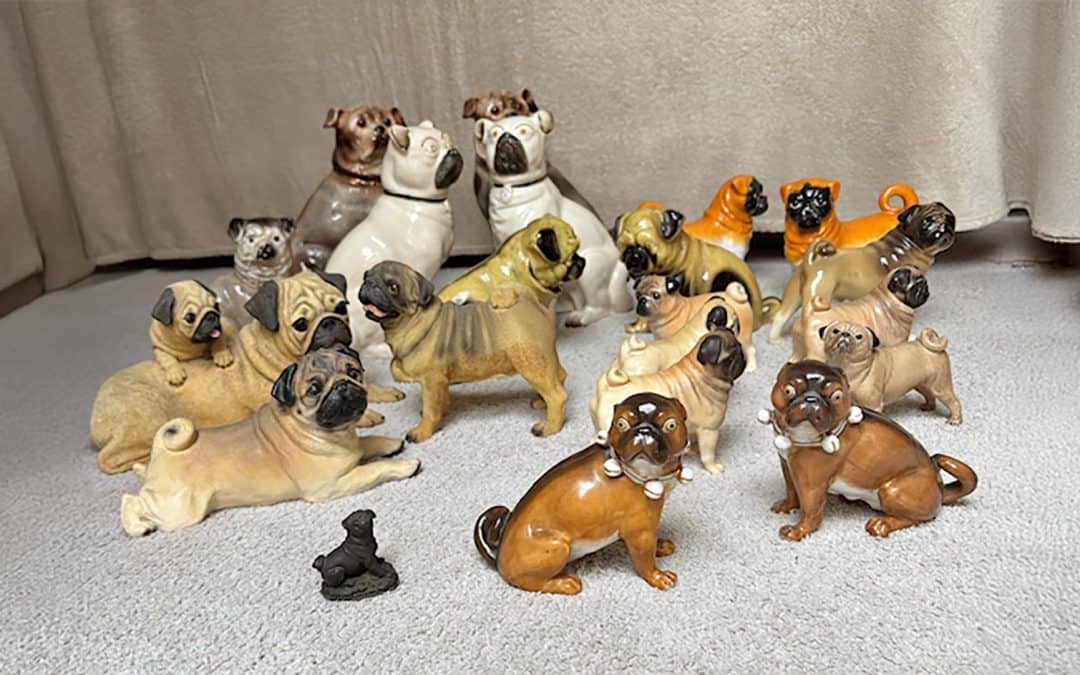
by Yasmin | 7 Aug, 2025 | Blog, In Memoriam
Loveday’s father leaves his beautiful collection of ceramic pugs to the PDWRA.
My father was a pug enthusiast for most of his life. Shortly after my parents married, 70 years ago, they welcomed a pug called Bunky into their lives and things were never the same again. Growing up, I can’t remember a time when there wasn’t at least one pug, often more, in our family, and this continued for the rest of my Dad’s life. The pugs’ larger than life personalities and snuffly enthusiasm for food, walks and comfort took priority in all aspects of domestic life including holidays (of course the pugs never went into kennels!).
Over the years, Dad registered with the PDWRA as an adopter and took on a succession of pugs in need of a safe, loving home. He helped them through their trauma and health issues so that they could live their lives happy, warm and without fear. His commitment meant that he sometimes drove hundreds of miles from his home in Cornwall to collect a pug that needed rehoming. His last pug, Ruby, was left partly disabled after being badly abused as a youngster, but Dad answered the PDWRA’s call for help and looked after her for many years. After Dad died in 2024, we reached out to the PDWRA to re-home a now elderly Ruby, who was missing her favourite human terribly. The volunteers were fantastic, quickly identifying a wonderful new home where Ruby spent her final months in the lap of luxury alongside some very friendly pug companions.
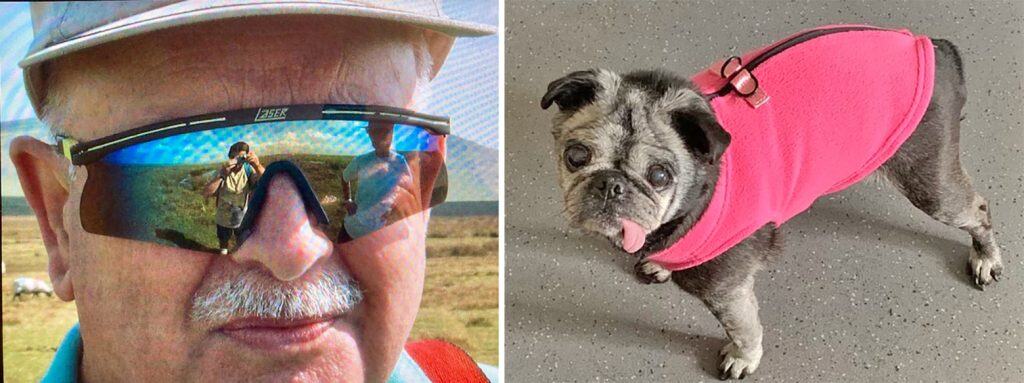
Pictured above is Loveday’s father, alongside his last pug Ruby
Dad’s pug obsession extended beyond the furry ones, and he built up a collection of ceramic pugs, always on the lookout for new additions. There is a mix of old and new items and Dad enjoyed them all, but he also wanted to use them to help the pug rescue community. So, in his will he gifted them to the PDWRA with the intention of them being sold to raise funds for the organisation he was proud to support. I’m so pleased that the PDWRA has accepted this legacy and will be doing just that. Dad would be so pleased that his collection will help pugs in need and have a new life with fellow enthusiasts.
Loveday Lamb
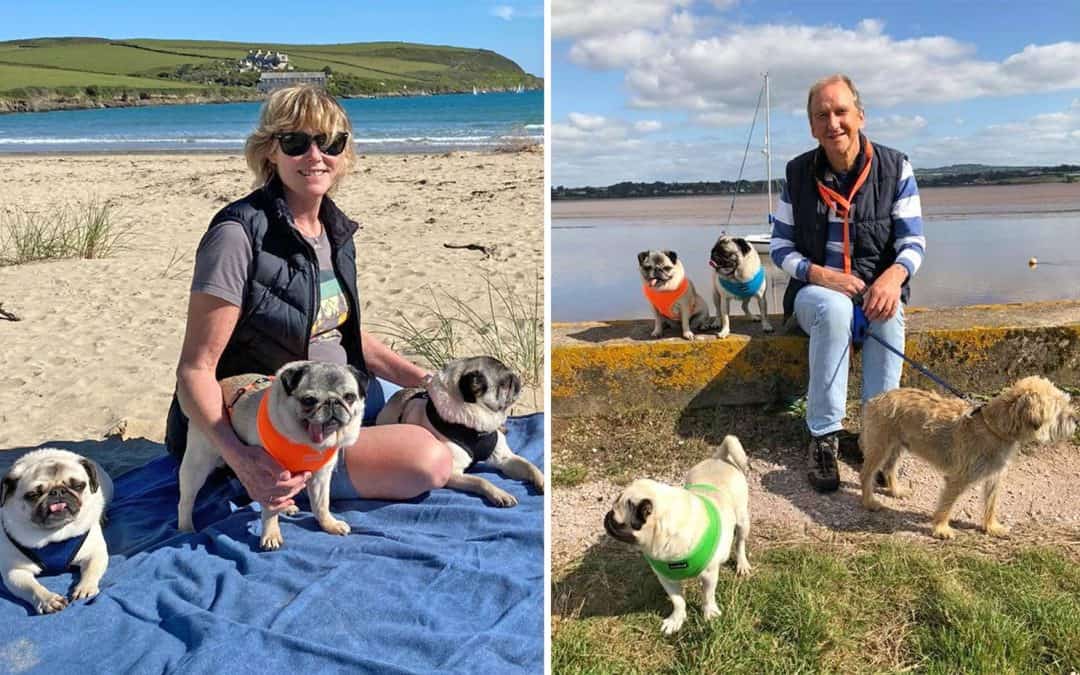
by Yasmin | 7 Aug, 2025 | Blog, News
We are saying a sad farewell and a huge thanks to Helen & Malcolm McKee – Voluntary Vet Advisors to the PDWRA from 2018 – 2025
Helen first became involved with the Charity in early 2018, when she made an initial approach to enquire about fostering. At the time, she said ‘I volunteered my services at the local donkey sanctuary for a brief period, but I need a role that will keep the grey matter working’.
In June of 2018 Helen & Malcolm collected and fostered a fawn female pug called Suki, aged 8yrs. Suki required BOAS surgery, plus an extensive dental overhaul, and her adoption happened very quickly, as both Malcolm and Helen soon became besotted with her.
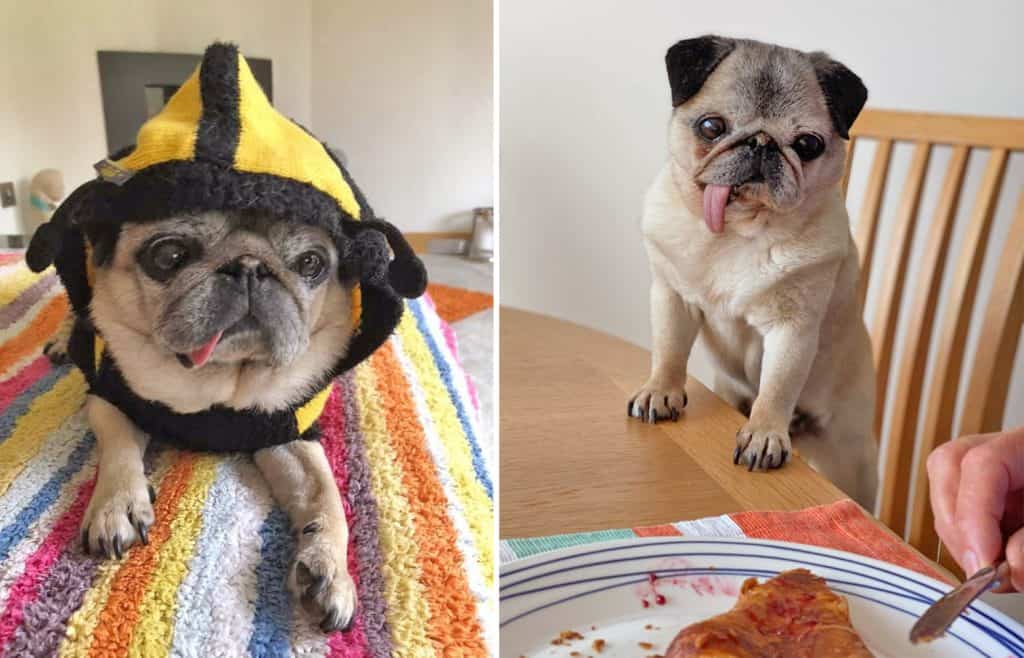
In the months that followed, Helen took on the role of Volunteer Area Coordinator for the Wales region. Through the experience of doing this job, Helen and Malcolm both became very aware of a need to support and advise all of the area coordinators around the UK with valuable veterinary advice. Over time, they both became voluntary veterinary advisers to the Charity, giving a huge amount of their time to supporting the hundreds of pugs coming into our care and overseeing their medical treatment.
Helen and Malcolm have both been absolute rocks for the Charity over the last 7 years and done so much to help pugs in need to live their best lives. It’s very hard for us to imagine the Charity without them, constantly on call to offer much needed help and advice, but they have now come to the very hard decision to take a step back in order to be able to spend valuable time with their growing grandchildren.
Over their time spent helping the Charity, Helen and Malcolm fostered a total of 10 pugs. All of us at the PDWRA will miss them both terribly and will be eternally grateful for the gracious and caring way that they shared their valuable knowledge for the huge benefit of everyone involved.
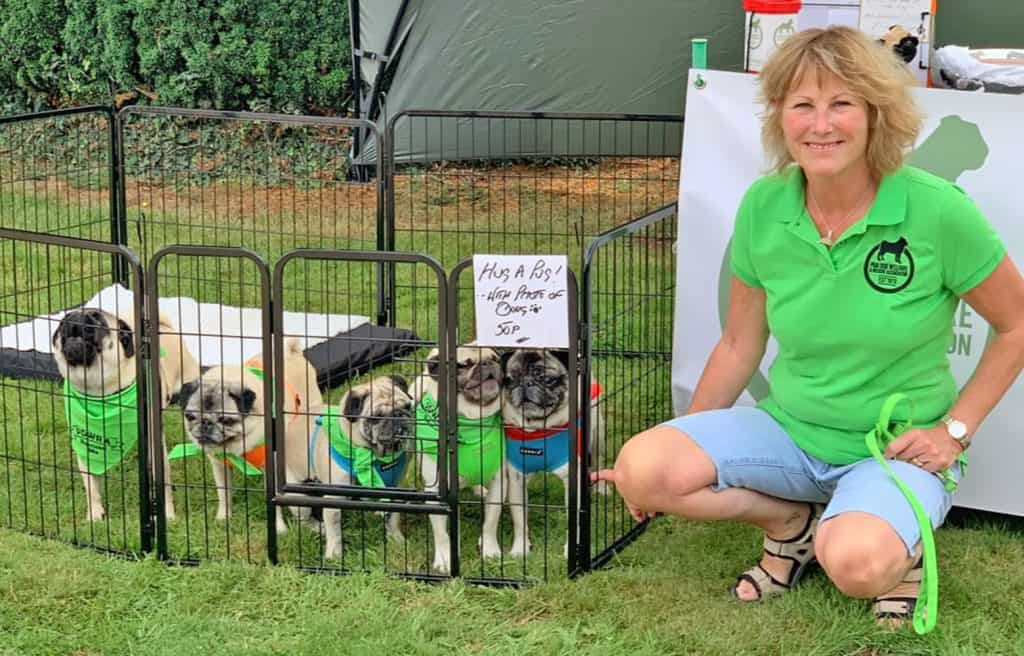
*******
Helen and Malcolm provided regular pug-health articles on many topics. These can be found in our pug health section:
Pug Health & Wellbeing

by Yasmin | 7 Aug, 2025 | Blog, Pug Health
Written by Helen McKee
PDWRA Veterinary Advisor
I am sure all of you, and anyone who has had a pug, is familiar with the term ‘BOAS’. It stands for Brachycephalic Obstructive Airway Syndrome’
It is a large topic and there is much to discuss about the condition, but hopefully I will keep it concise and in a way that can be understood. It’s also a controversial subject due to the impact it has on a dog’s (pug’s) health and welfare.
It’s a condition that has been created by the breeding of dogs so they have little or no snout.
This has then resulted in all the soft tissues at the back of the throat being squashed into a smaller space. The nose structure, both externally and internally, can be abnormal, but more importantly (for pugs), the soft palate (and tongue) are too large for the size of a pug’s head and throat.
The most significant part (for a pug) is an excessively long soft palate, which obstructs the airflow through the larynx (access at back of throat to lungs) into the trachea. This leads to a rattling noise or what is known as ‘stertor’, and less air being able to reach the lungs. This affects a pug’s ability to exercise (exercise intolerance) and is exacerbated by carrying any excess weight, particularly because pugs carry extra weight around their necks.
This is why the condition is controversial; we have bred a dog that can’t breathe properly, which is a welfare issue. In the Netherlands it is now illegal to breed a dog without a certain length of snout.
The condition can vary from mild to severe, with extreme cases fainting (apnoea) due to lack of oxygen. The sooner this is addressed, the better, in order to prevent secondary problems developing which cause further breathing issues.
Secondary changes can occur when the obstruction of the soft palate is left without treatment (chronic). Because the airway is blocked by the tissue, it creates a negative pressure at the back of the throat causing the larynx to collapse. With time, the laryngeal tissues become damaged and soft. The negative pressure can also cause the tonsils to evert out of their crypts, and the so-called laryngeal saccules to do likewise. These everted structures then cause further obstruction in the airway, which becomes a vicious cycle.
Dogs who have these secondary changes make a different noise, ‘stridor’, which is more like a wheeze rather than a rattle.
Another condition which results from the long-term negative pressure caused by the obstructive long soft palate, is gastric reflux. The sphincter at the top of the stomach gradually becomes loose due to this negative pressure, resulting in gastric reflux. Signs of reflux are stretching out of neck, licking lips and regurgitation.
This can become a potentially life-threatening condition, especially when a pug is anaesthetized. Material can become sucked (aspirated) into the lungs, a condition known as aspiration pneumonia. For this reason, all brachycephalic dogs should be given the medication ‘Omeprazole’ prior to a general anaesthetic.
The treatment for BOAS is surgery. If there are no secondary changes, BOAS surgery tends to involve the reduction of the soft palate and widening of narrowed (stenotic) nares. In my opinion, and in fact mentioned by Dr Rowena Packer (an expert in BOAS) in the book ‘Health and Welfare of Brachycephalic Companion Animals’, widening of a pug’s nostrils is rarely a cause of BOAS.
Quoting Dr Packer :- “Previously, stenotic nares were thought to be of paramount importance, and early treatment was advised to open the nostrils….. Recent work from the Cambridge BOAS Research Group shows that the nostrils in the French Bulldog are of particular importance (not pugs). It is worth noting that we have seen mature dogs with no BOAS-related respiratory signs yet with severely stenotic nostrils.”
This is certainly my experience; I have rarely seen narrowed nostrils in pugs causing breathing problems, and I personally feel widening a dog’s nostrils has become a bit of a trend without assessing if it’s actually causing a clinical problem.
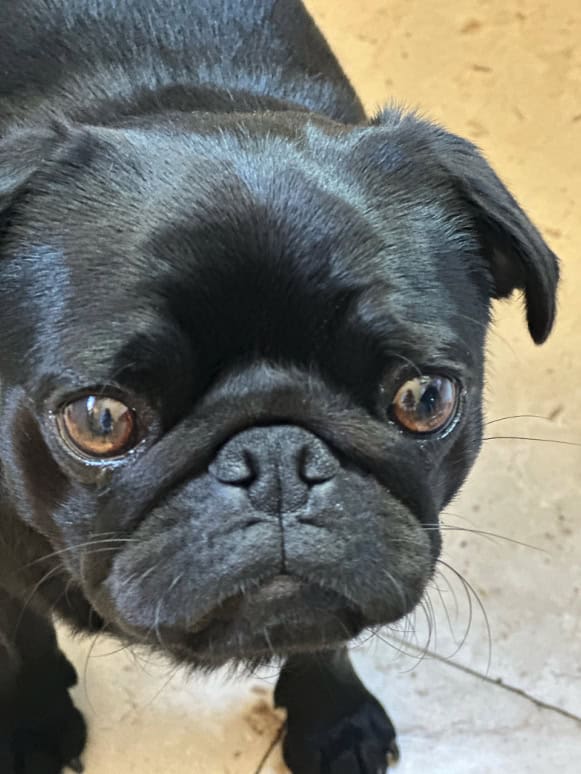
This is a photo of our rescue pug Molly, with her significantly stenotic nostrils, however she runs 7 miles daily and breathes comfortably.
If a dog’s mouth breathes when at rest, then this indicates they are unable to breathe through their nose. However, widening the nostrils may not resolve the issue, as often there are abnormalities in the nasal structures (turbinates) due to the extremely shorted muzzle, which compromise and block airflow through the nose.
Although BOAS surgery is generally straight forward when there are no secondary changes, it is best carried out by a veterinary surgeon with experience / extra qualifications (Specialist or an Advanced Practitioner in Surgery). Swelling can occur at the back of the throat immediately post-operatively, which needs to be managed carefully. When there are secondary changes, the surgery carries a greater risk of complications, including death.
It used to be the case that surgeons would remove the laryngeal structures that had everted and were blocking the access to the windpipe (tonsils, laryngeal saccules), however, recently specialists have been removing the soft palate tissue only, as this carries less risk of bleeding and swelling post operatively, and it has been found these structures may go back into their natural position once the ongoing negative pressure is removed.
These dogs need to have close management post-operatively to watch for any signs of swelling/laryngeal collapses causing breathing difficulties. They also need to monitored for aspiration pneumonia; personally, I have had a foster dog who had severe BOAS, die of aspiration pneumonia following BOAS surgery.
Damage to the tissue of the larynx is generally irreversible causing softening of the larynx (malacia) and collapse. Laryngeal collapse is graded from one to three, with three being the worst affected. This can be managed conservatively (controlling exercise, not allowing the pug to get hot or too excited) and feeding from a height (‘fluff trough’). However, some vets will advise removal of cartilage from the larynx (arytenoid cartilage) or ‘laryngeal tieback’.
In my opinion, both procedures carry greater risk and are not a panacea, and I would not advise this to be performed on a pug; both can lead to a significant increased risk of aspiration pneumonia (where fluid/food is aspirated into the lungs) which is discussed above.
In summary, due to the abnormal shape of a pug’s head, they can suffer from obstructive breathing issues (BOAS) that can significantly and adversely affect the health and welfare of a pug. The earlier surgery is carried out, the better the outcome and the less likelihood of developing secondary changes such as laryngeal collapse and gastric reflux.
The surgery does carry risks, especially when the condition becomes chronic and the dog has developed secondary health problems, however, if a pug has clinical BOAS and it is not surgically corrected, they will have breathing difficulties which will worsen with time, affecting health, welfare and ultimately, the life of the pug.
Helen McKee
Veterinary Advisor
PDWRA
2018-2025
******
To read more about Pug Health from our website, please go to the following pages:
https://pugwelfare-rescue.org.uk/pug-health/
https://pugwelfare-rescue.org.uk/seasonal-hazards-for-pugs/
https://pugwelfare-rescue.org.uk/pug-health/fit-not-fat/
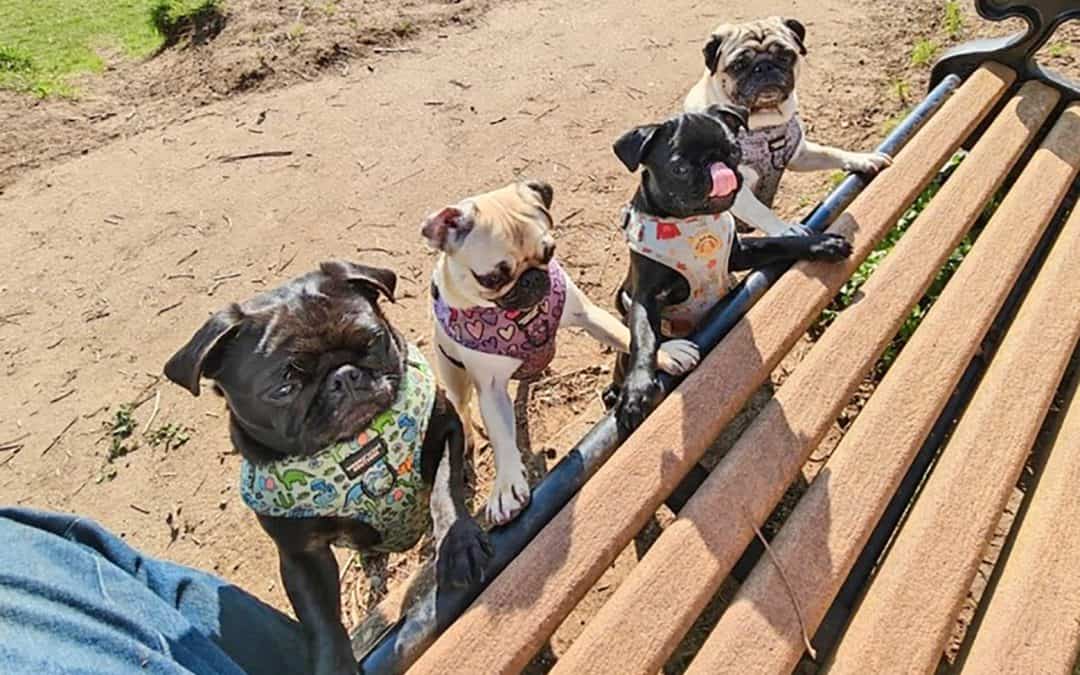
by Yasmin | 7 Aug, 2025 | Blog, Fundraising
Emma raises funds for the PDWRA as part of her company’s Volunteer Week!
Over the past year, I’ve had the privilege of taking part in a few volunteer initiatives that have been both meaningful and memorable. One of the highlights was volunteering at a high school in New Jersey, where I helped provide interview experience for students preparing to enter the workforce. It was incredibly rewarding to support young people at such a pivotal moment in their lives and help boost their confidence as they navigate their first professional steps.
I also took part in a fantastic global initiative called Be My Eyes, a platform that connects volunteers with blind and partially sighted individuals who need assistance with everyday tasks. One particularly touching moment was helping a blind father choose the colour of icing for his daughter’s birthday cupcakes. A small act on the surface, but incredibly meaningful to be part of that celebration in even the tiniest way.
Through this initiative, I was able to convert my volunteer hours into donation points, which my company then matched as part of our annual volunteer drive. This is something we do every year, and it brings out a great sense of community (and a bit of healthy competition!) between departments to see who can log the most volunteers!
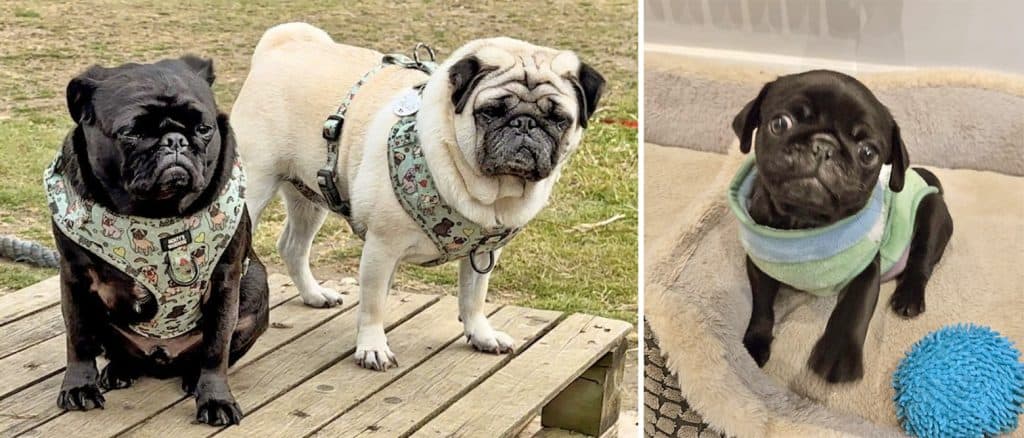
On a more personal note, life outside of work revolves heavily around our four pugs: Ernie (our ‘chonky boy’), Murphy (a lovable troubled soul), Winnie (who’s more cat than dog) and Spike (who we often say should’ve been named Dennis – as in the Menace). They are the centre of our world.
In fact, we recently made a big move from Kent to Lincolnshire, with them at the heart of that decision, as we wanted more space and a better quality of life for them. Ernie and Winnie came from a wonderful, registered breeder, who remains very involved in their lives to this day. Murphy and Spike, on the other hand, are both rescues with rough beginnings but hearts of gold.
Murphy was rescued from a drug den and took time to settle, but he’s now deeply loved. Spike, the runt of his litter, was heartbreakingly going to be abandoned by a backyard ‘greeder’ just a week before Christmas. As the saying goes, ‘One man’s rubbish is another man’s treasure’ and those two are certainly treasures in our home. Whether it’s volunteering in the community or making sure our dogs have the best life possible, giving back, whether to people or pugs, is something we really believe in.
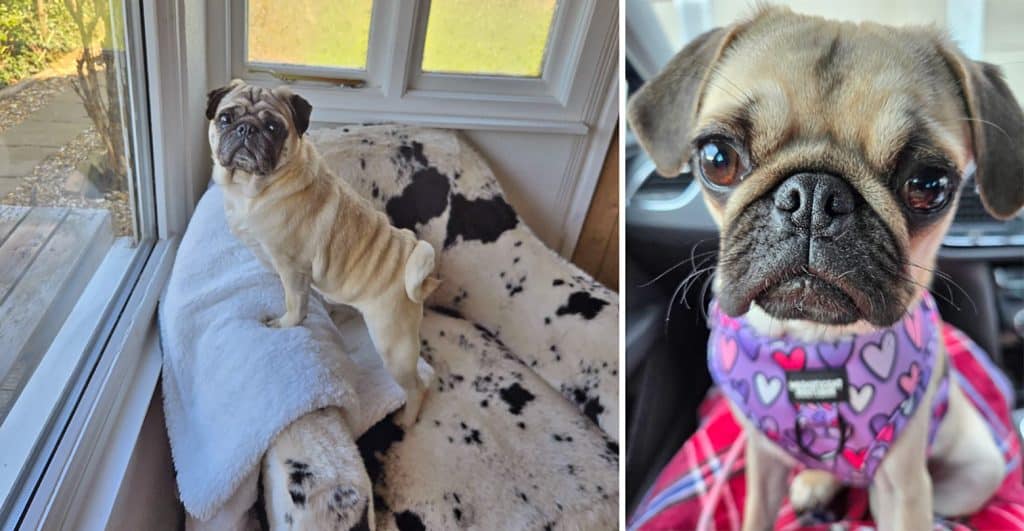
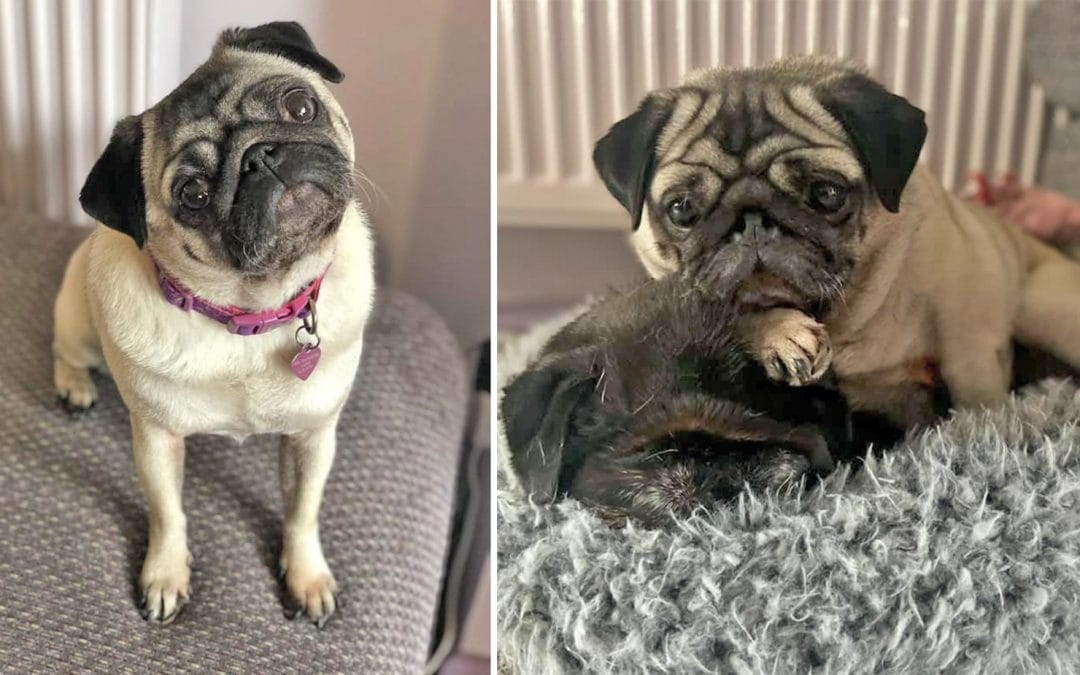
by Yasmin | 7 Aug, 2025 | Blog, In Memoriam
The life and times of Little Lottie, aka Crazy Girl, aka Stinky Minky.
It was the 23rd of August 2018 when I pulled into an Asda car park in Newmarket to collect “the goods”, aka Lottie, an approximately 3–5-year-old fawn pug. She was my second pug adopted from the PDWRA, and I had driven halfway between my house and her foster’s house to collect her. At this point, I had a 4-year-old fawn boy called Branston, and a 10-year-old black boy, Archie, who was my first PDWRA pug, whom I adopted 2 years prior. I was ready for a girl, and 3 is the magic number after all, but I wasn’t quite prepared for how unique and absolutely bonkers Lottie was.
I first noticed on the way home that she just would not lie down like a normal dog. She was on my lap (don’t worry; I wasn’t driving), with her blanket, but she kept pushing back on her front legs and lifting her head up. I realised later that this was the beginning stance for her classic ‘back drop’ move, which happened whenever in the arms of someone capable of rubbing her belly – which it turned out she was practically addicted to.
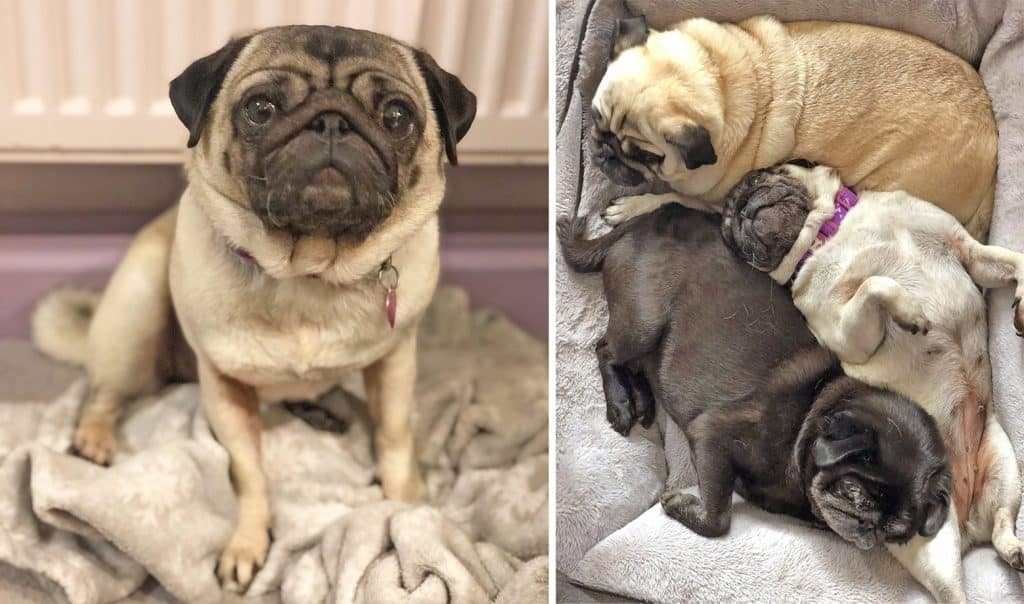
Lottie settled in fine with the boys. She was getting lots of attention from Archie, and I later ended up calling her his ‘sister-wife’ as they were obsessed with licking each other. Archie was especially partial to chewing- or gumming- on Lottie’s ears.
Despite settling in well, it wasn’t long before Lottie’s past caught up with her in terms of her health. On her first day with me, she had stitches from her spay and BOAS surgeries and was completely bald from her chin all the way down to the underside of her tail, and on most of her feet because of demodectic mange. Her claws were thick and overgrown, and she was missing a couple of toes. When I adopted Archie, the extent of his health problems were bad teeth and an ulcerated nose crease, so it was quite a shock to realise just how much the girls suffer after having been bred. I quickly noticed that Lottie’s eyesight wasn’t the best, which turned out to be advanced pigmentary keratitis, and she spun around like the Tasmanian devil whenever she was excited – this could have been from being crated for most of her life, or potentially some brain damage from lack of oxygen during labour, something we would later decide was the most likely (for all her cuteness she didn’t have the most powerful brain) but it was the onset of her recurrent UTIs that really became her biggest hurdle.
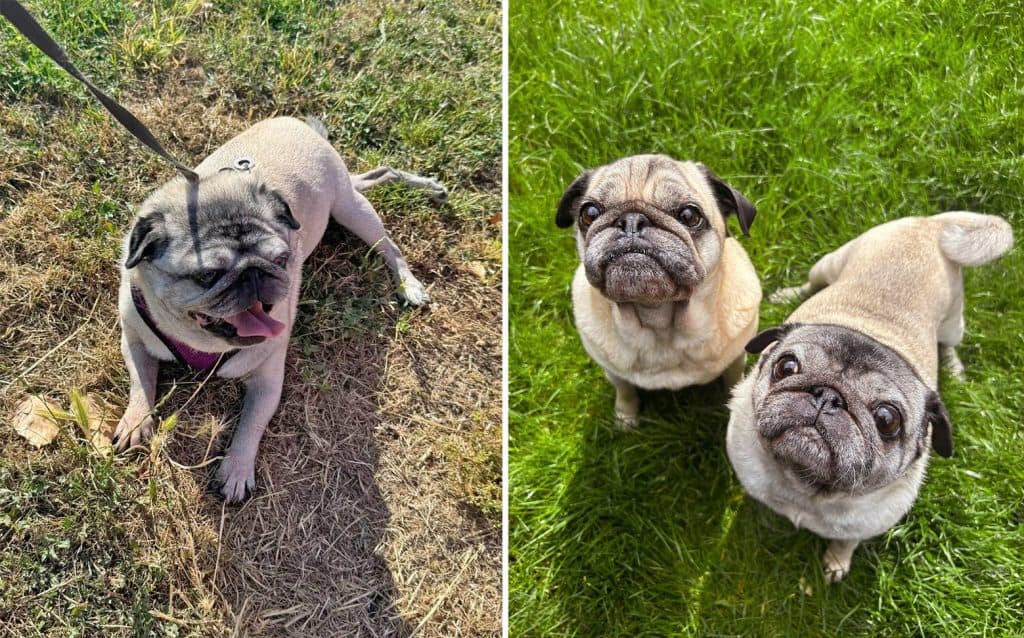
She had investigations done after nothing seemed to clear her UTI’s up, and it was concluded that in her short life, being bred and not cared for properly meant that her bladder wall had thickened, and her urethral sphincter was weak. A bucket load of medications and specialist food later though – and she was cured. Hurrah!
This is when we had a few great years with a bouncy, super fluffy, mad as a box of frogs Lottie. She struggled in the cold weather with her front foot that was missing a toe, but nothing that inventive boot manufacture couldn’t solve. She even managed to learn a couple of tricks, one of which was running and jumping into my arms using my slightly bent legs as a springboard. She had incredible speed, and her back legs were built like a sprinter, she definitely had a tush on her!
In the later years of her life, some of the problems of the past came back. A couple of years after losing Archie to cancer in 2021, Lottie started getting a little bit wobbly in her back legs, the once sprinter and thick-legged girl was now stumbling. It didn’t stop her though, even when she started leaving poopy nuggets around the house (which she had no idea she was doing!).
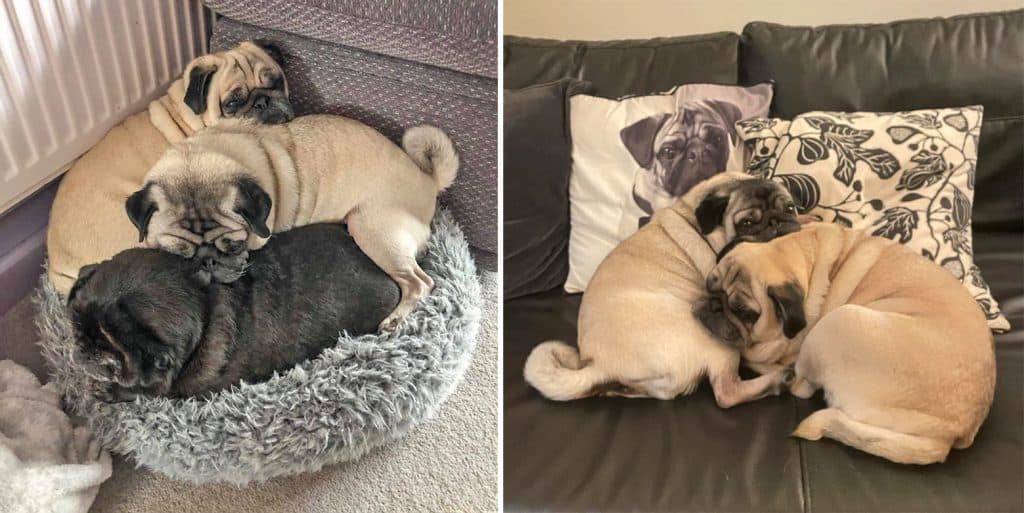
The pug myelopathy took its toll though, and despite absolutely loving her pram walks and sniffing the air, she became doubly incontinent in 2024, which started with another UTI, her first in years. But as Lottie had the privilege of almost complete ignorance, she was still happy as Larry, so we began expressing her bladder, and even though the UTI took a long time to clear up and at one point we thought it might never go away, it cleared up and we carried on in this routine for a whole year with no more bladder issues. (She did have a spell of colitis, which I’ll spare the details of, but as you can probably imagine, an incontinent pug who drags her legs and spins in circles and has NO idea she is doing it was… an experience. My partner now has PooTSD.)
In the last six months of Lottie’s life, she slowly deteriorated. She developed another UTI, just over a year after her last, and her breathing became very bad. She seemed to be less ‘with it’, and after trying a few different medications, we decided it was time to unite her with Archie and send the crazy girl over the rainbow bridge. We don’t know how old she was, probably around 12 or 13, so after nearly seven years with us, she won the hearts of everyone with her quirky and bonkers personality, and often quite baffling habits. Branston is back to being an only pug, which I’m sure he is fine with, as neither Archie nor Lottie ever wanted to chew on his ears anyway!
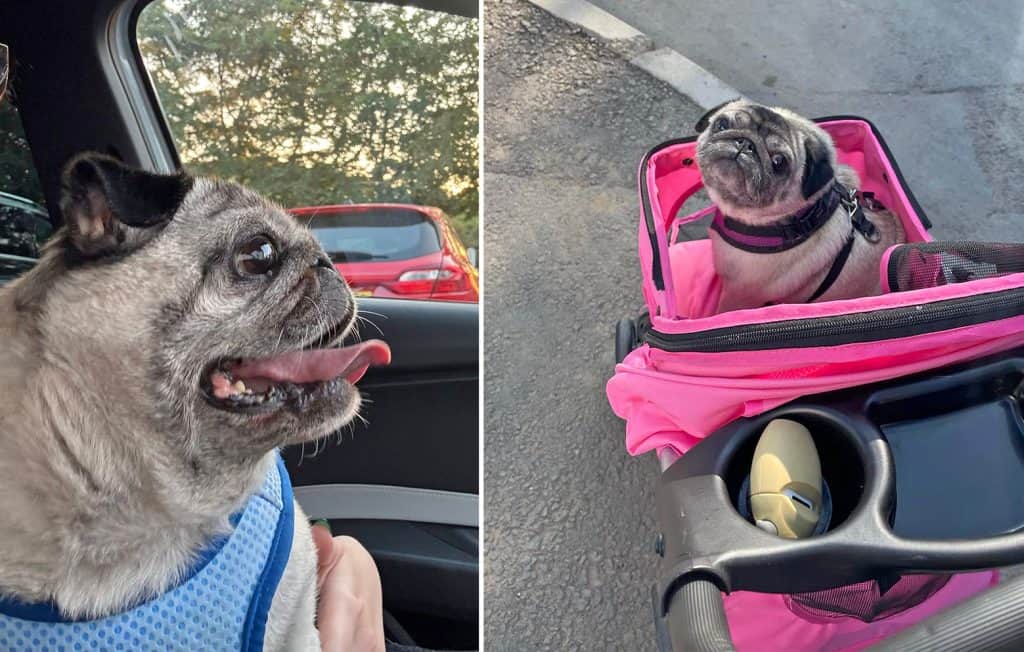
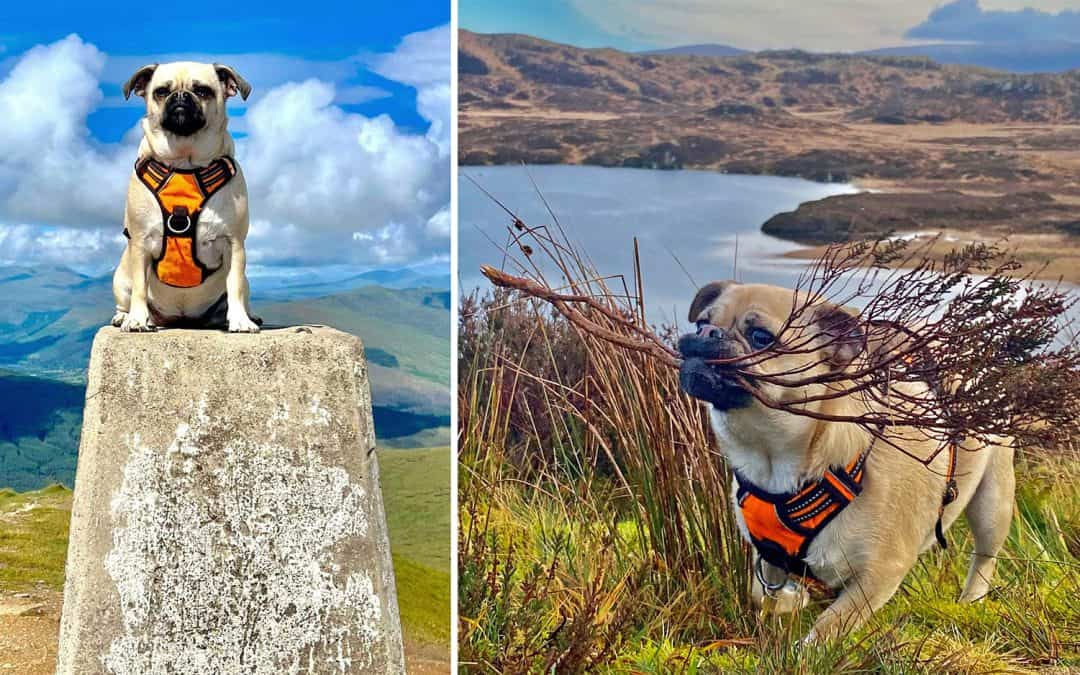
by Yasmin | 7 Aug, 2025 | Blog, Rescue Stories
How did you first hear about the PDWRA?
We hadn’t heard of the PDWRA until a few years ago, they had a stall at a dog show raising funds.
How did you come to make the decision to adopt through the PDWRA?
We contacted several charities hoping to adopt a small dog in need of a loving home. Many charities stated we had to be within a 45 minute drive of the rehoming centres, the PDWRA website did not state this on the request form, so we got in touch.
When did you adopt Soks?
We adopted Soks when she was 8 weeks old, in September 2022.
What made you decide to adopt?
Our daughter and her dog moved home, the house felt empty without them. We were searching for a small dog that required re-homing and would enjoy walks.
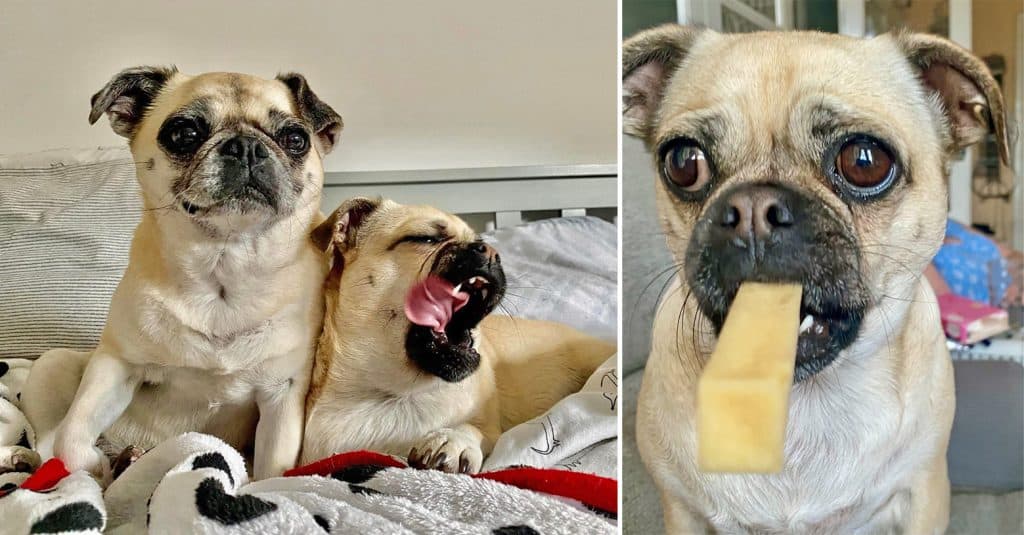
Can you tell us a little bit about Soks?
Soks is a female Chug. Her mother is a pug and her father Chihuahua. Sok’s mother was taken in and homed by a PDWRA foster carer, at the time they were unaware that she was expecting 4 puppies. Soks had a temporary name of ‘Gloria’ due to all the puppies being named after ‘Madagascar’ characters and Soks having the rear end of a hippo! Her name was instantly changed once adopted to Soks, due to her white paws. She has an underbite that turns into a huge smile when she’s happy and a menacing grin when mischievous. She loves everyone, is extremely sociable with humans and other dogs, and well known locally to all that have met her. She often spends holidays with Mia the Chug and adores playing on the beach and running in the sea. Every evening before going to bed she goes into the garden, looks up at the neighbour’s windows and barks, waiting for them to waive goodnight to her. Her favourite TV programme is ‘The Dog House’ on Channel 4!
How did you find the adoption process?
We filled out the online form to adopt or foster, had an online interview that required us to give a brief tour of our home, then we waited (dogs were still in demand due to COVID 19). We received a phone call asking if we would consider adopting a puppy as we’d requested an older dog. From there, we visited the foster carers home to meet the puppies, Soks chose us, and we returned to collect her when she turned 8 weeks old. The process was easy, with ample support and guidance (Huge thank you to all the foster carers and all involved with PDWRA).
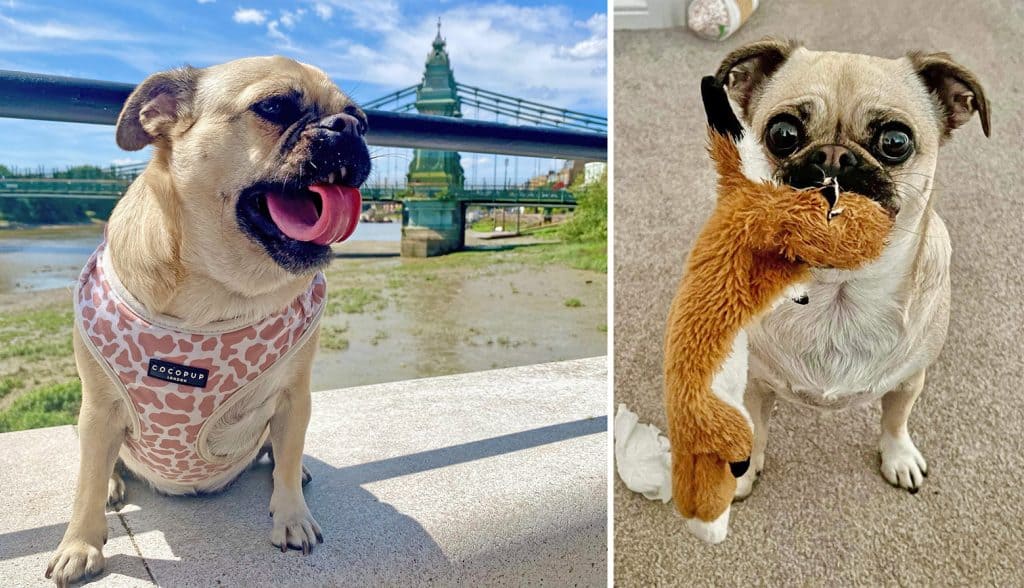
Anything you think prospective adoptive or foster parents should know?
If taking on a puppy, be prepared for sleepless nights and a hive of activity, followed by short naps and mischievous behaviour. We were extremely lucky that Soks required very little to no house training. Chugs aren’t lazy and Soks enjoys long walks, socialising with other dogs and daily zoomies. She can recognise all food and social locations that sell pup cups or have gravy bones. Don’t expect a Chug to forget any of these locations, walking pass is not an option!
What has life been like since adopting Soks?
The first 6 months can only be compared to a 2yr old mischievous human baby. The following years encourage you to explore the outdoors, enjoy the snuggles and the love a dog gives, meet other dog owners and give up 70% of your bed, as a chug takes up far more room than a herd of sheep when it comes to having personal space!
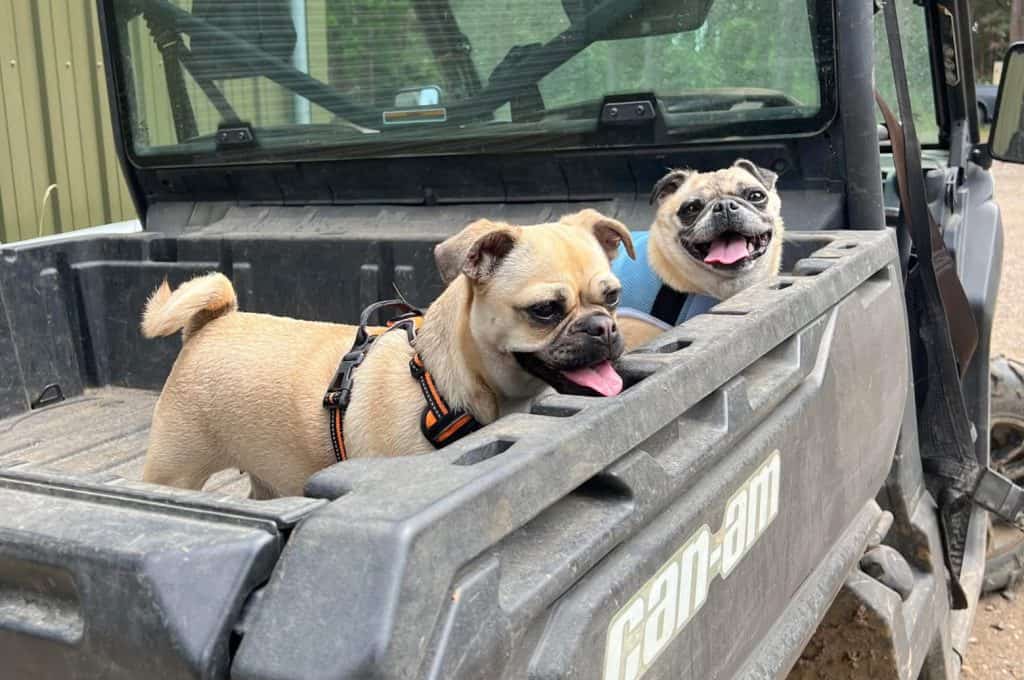
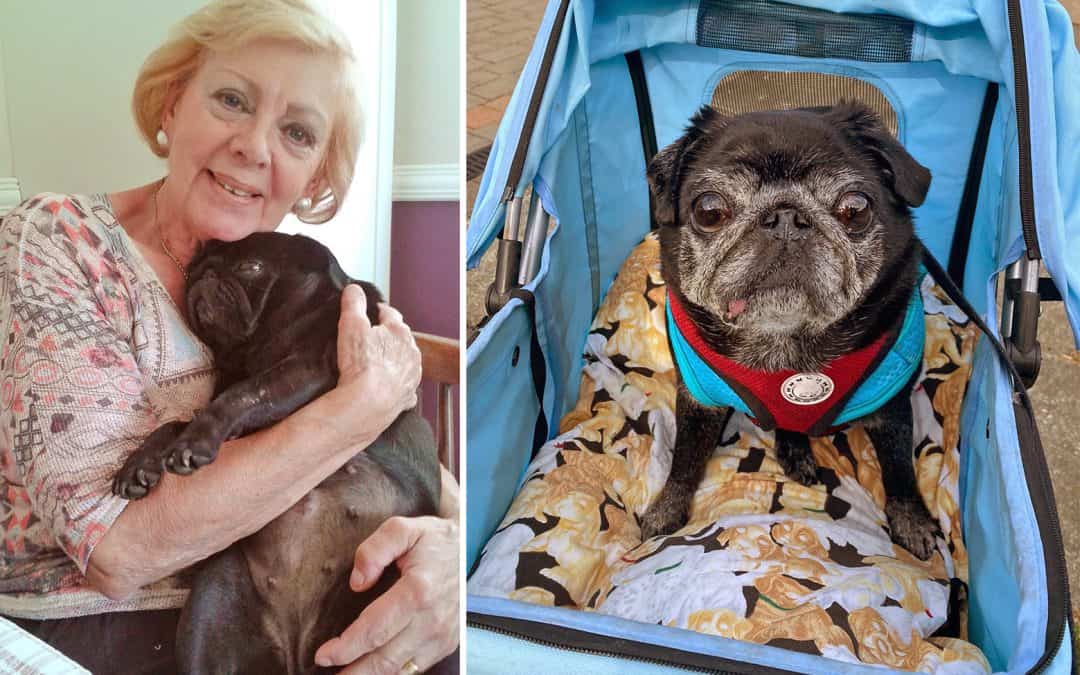
by Yasmin | 6 Aug, 2025 | Blog, Rescue Stories
In April’s newsletter you may have read the article about Laura & her pug Ethel and how her pug story began 40 years ago. Well following on from that, as Laura is my daughter, here is my story of how I discovered Pug Welfare and my pug journey.
Having bought from a breeder, our first pug Honey in 1984, during a chance meeting while out on a dog walk with Honey a fellow pug owner told me about PDWRA and the annual Pug Days at Crowhurst. We sadly lost Honey in 1994 and after her loss we decided to go down the rescue route as PDWRA seemed such a great organisation to adopt through. Over the past 30 + years I have had the pleasure of adopting :- Hanky Panky, Millie, Lily, Mabel and finally, our precious Black Betty, who has been with us for the past 10 years.
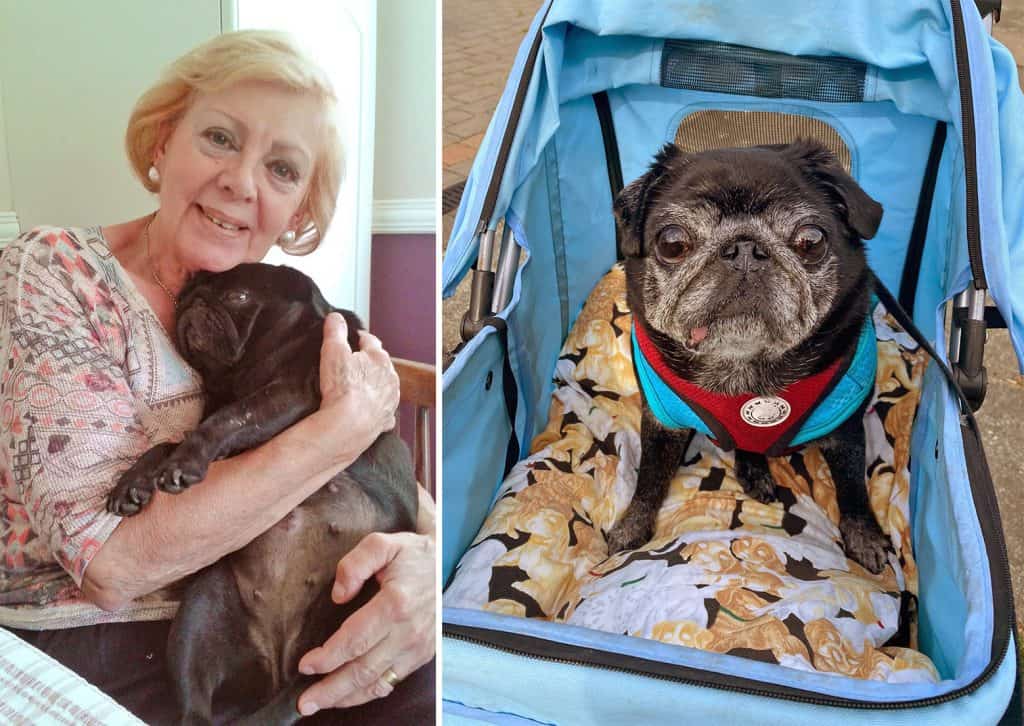
I found the process of adopting through PDWRA quite straight forward and it became easier for us as time went by, after each adoption we didn’t have to wait too long to receive a call from Pug Welfare with our next adoptee. Over the years, all our girls were taken to almost every Welfare Day at Crowhurst from 1987 until 2016, when sadly they became no more. They were a great day out, games for the pugs, raffles and various different stalls, plus the much loved auction to raise money for pug welfare. Another not to be missed PDWRA occasion were the Pug Tea Parties that were held once or twice a year during the summer months, the pugs and the humans always had a great time!!
The pugs I have adopted have always enjoyed a holiday away with us, over the years they have been to Yorkshire, Norfolk, down to Devon and to West Sussex, and nearer to us on the Kent coast. I must say, although the girls have always enjoyed a change of scenery, running on the sand – definitely not in the water! or enjoying a new walk and smells in the Countryside, they always loved getting home, back into their comfort zone! This goes especially for Betty, she’s a real home pug and loves her daily routine.
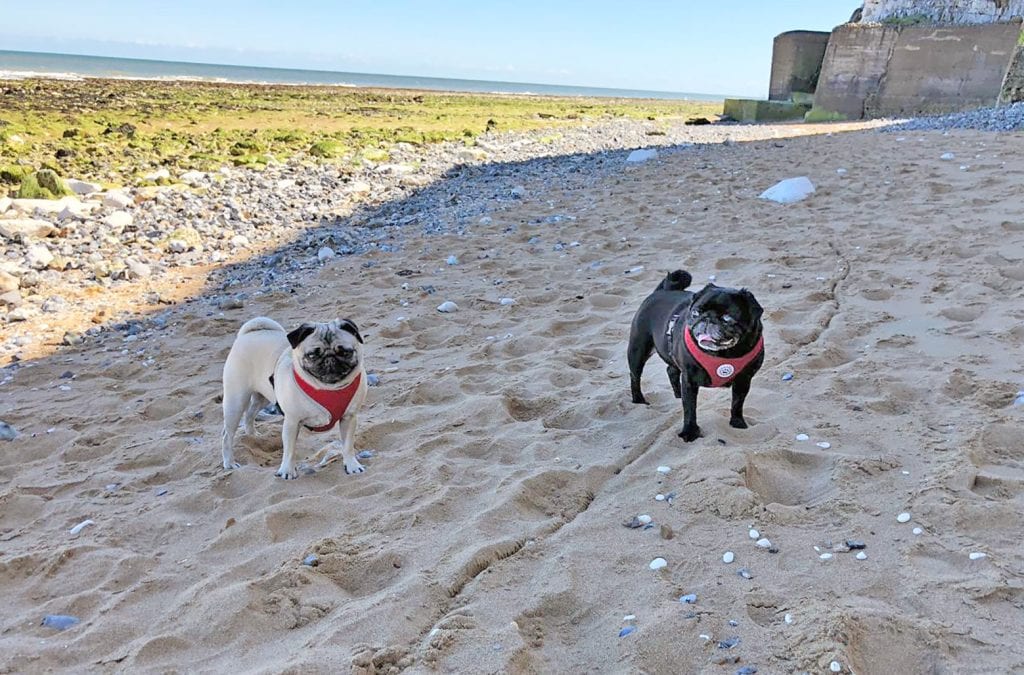
We adopted Betty in 2015, she was a little over 5 years old and my most vivid memory of her is arriving at 2pm on the 26thMarch. Judi and Andrew pulled onto the drive and out jumped the prettiest, bright eyed little black pug, who promptly breezed into our lives as much to say “well I’m here”! She had a quick look around, made sure she had no opposition and everything met with her standards and approval, checked out the garden, christened the grass and decided she’d stay!!!
Betty has been a joy to have in our lives, as an elderly lady now she has become even more feisty and stubborn, aging ladies do have that privilege. Her sight is not so good now and Betty has arthritis in her back, but she copes well with her eye drops and her regular injections at the vets and she still retains the loveable character she has always been blessed with. Due to Betty’s advanced years, she has just celebrated her 15th Birthday, her favourite pastimes now are eating, sniffing lampposts, barking at anything and sleeping, in any particular order!!
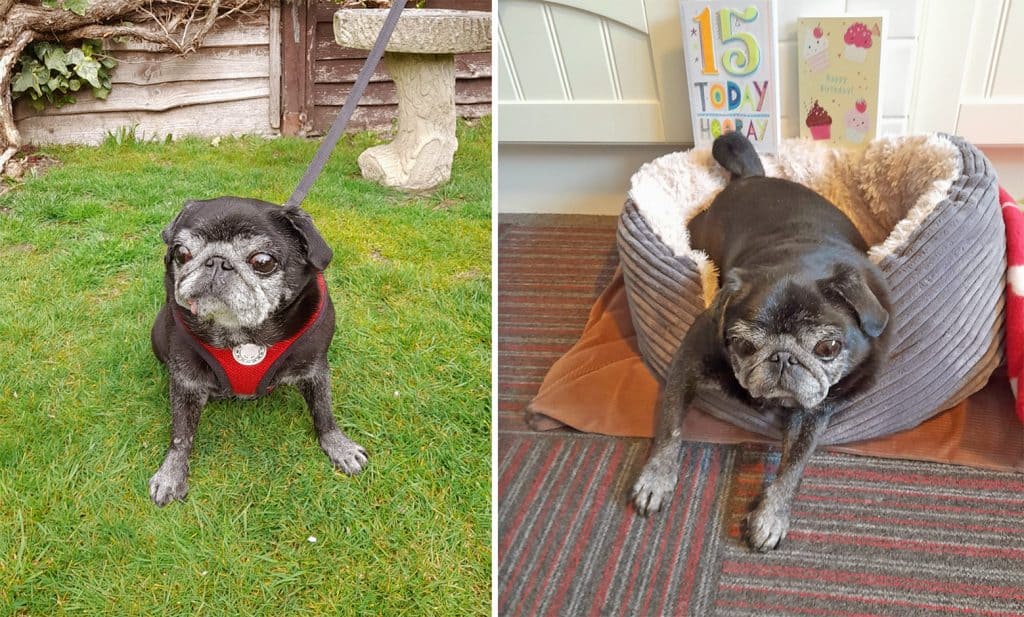
Obviously over the past 40 years there have been ups and downs with looking after a pug, the sheer overwhelming sadness when one of the girls have passed away, but such happiness when a new little pug arrives, full of enthusiasm to start a new life in their forever home.
If I was ever asked “would I pursue the adoption route again after over 30 years?”, I would answer a resounding yes in a heartbeat. Young, middle years or an oldie, each pug brings their own character and rewards you with love and the trust they give you, is such a beautiful thing.
I feel so grateful to have shared such a large part of Betty’s life, and parts of all the other girls who have gone before, and also my 35 years of being part of such a wonderful pug charity. Plus, the added assurance that you are always able to contact PDWRA if you need any medical advice or support, the members are always there to help and advise.
Hopefully PDWRA will continue their brilliant work rehoming our lovely breed for another 50+ years!
*****
If you could provide a forever home by adopting a pug in need, please see latest details for applications at:
https://pugwelfare-rescue.org.uk/adopting-a-pug/
If you would alternatively like to help a pug along its journey by fostering, please see:
https://pugwelfare-rescue.org.uk/fostering-a-pug/
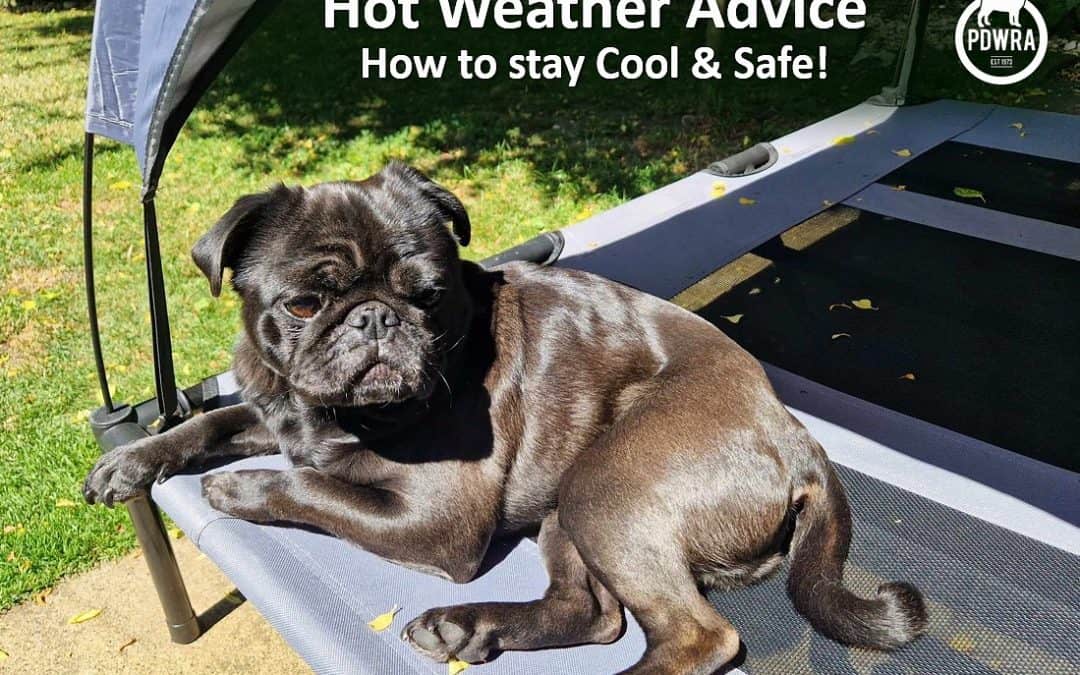
by Yasmin | 20 Jun, 2025 | Blog, News, Pug Health
As temperatures have been rising to above 30°C in parts of England for the first time in 2025, we are expecting further very warm or even hot conditions into the weekend with maximums over 30°C, before cooler and fresher air returns from the West.
This transition may also bring some thunderstorms in places.
So, here is our regular advice & tips for keeping your pugs, so sensitive to heat, cool, comfortable, and safe.
- Make sure your pug has constant access to fresh water – day and night.
- fresh fruit, chilled or frozen, make ideal refreshing & healthy treats to help keep them hydrated.
- Make sure your pug has constant access to shade and cool surfaces.
- Remember to move sources of shade as the sun moves around gardens.
- Provide cooling jackets and shallow paddling pools to enable your pug to cool down, and remember that carpets do not help pugs cool down, so provide cooling mats to help your pug cool down indoors and swap them for a spare cool mat regularly to ensure they are cool.
- DO NOT rely on fans alone to cool your pugs down as they are not as effective on pets as they are on us.
- Plan your walks
- Walk your pug in the early morning or late in the evening if the temperatures are cool enough and try to stick to shaded areas.
- If the mornings/evenings are still warm – DO NOT walk your pug!
- Particularly if they are overweight, have health issues, are elderly or very young.
- The Seven Second Test
- Tarmac /pavements even artificial grass can get very hot in the sun – hold your hand on it for 7 seconds. If it’s too hot for your hand it’s too hot for their paws. DO NOT walk your pug as they could burn their paw pads.

Temperature guide for deciding whether it’s safe to walk your pug/s.
- Below 12°C: Perfect walking weather! Your dog will be comfortable and ready to explore.
- 12-19°C: Safe for most dogs, but keep an eye out for signs of overheating if they’re running around a lot.
- 20-23°C: Start to take precautions. Stick to shaded areas, keep walks short, and bring water.
- 24-26°C: This is risky territory. Only take your dog out if it’s absolutely necessary, make it a quick, shady stroll, early in the morning or later in the evening.
- Above 27°C: It’s too dangerous to walk your dog. Stay indoors or let them relax in a cool, shaded area instead.
All dogs are individual & different, so always monitor how each of yours reacts to the heat and adjust their activity accordingly.
Here is a quick-glance, useful guide, regarding temperatures & risks.
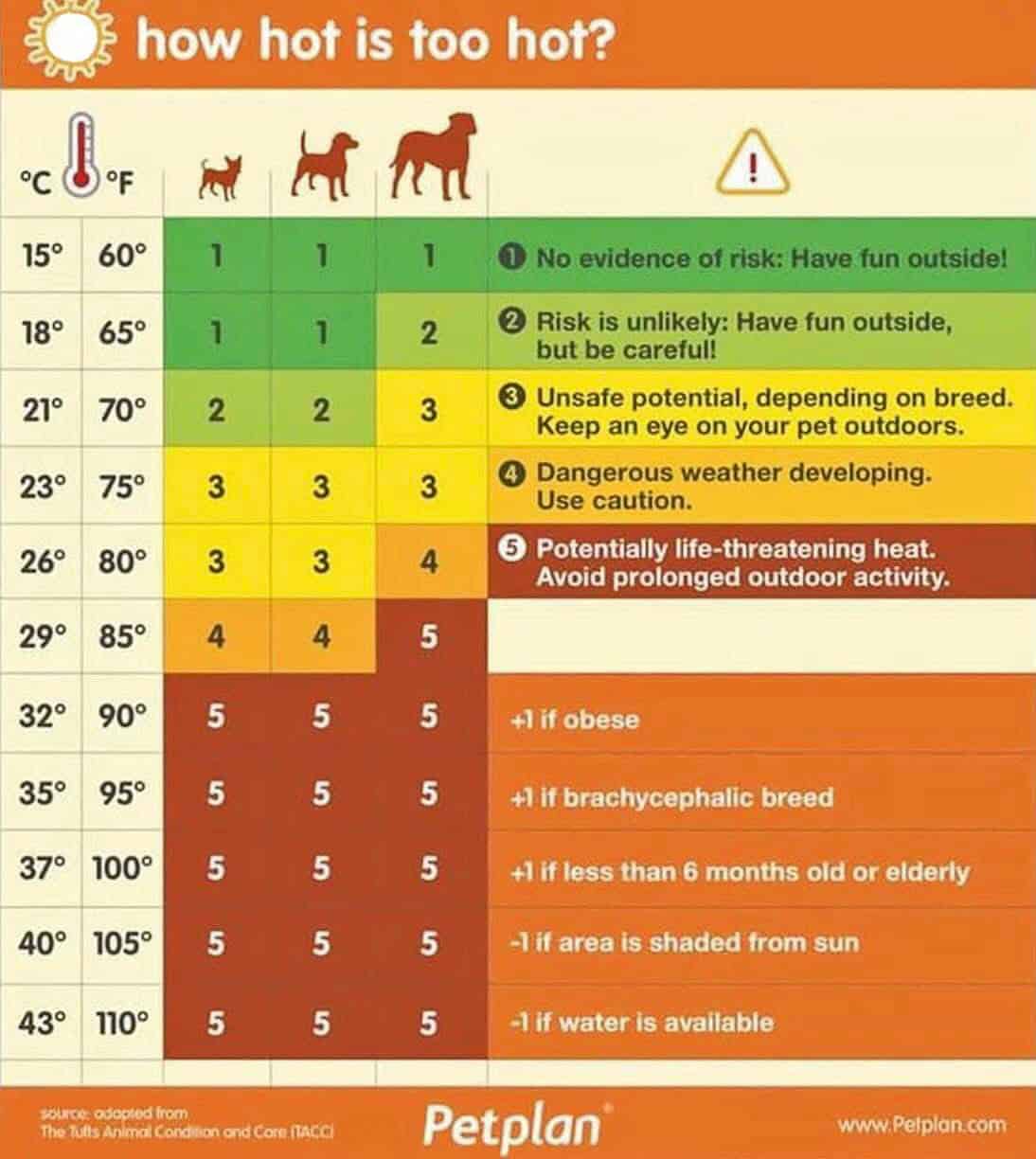
REMEMBER: NEVER leave your pug unattended in a car on a hot day – even if it’s just for a couple of minutes, even if you have left the windows open.

Pugs can die in hot cars in minutes!!!
******
HEATSTROKE.
This is an extremely dangerous condition that can develop if your pug gets too hot with limited ability to sweat and little or no nose/muzzle, they will struggle to lose heat through panting alone, more-so if they are overweight or have other health problems. Very old and very young dogs are most at risk.
Normal body temperature for a dog tends to be between 38-39°C (100.4-102.2°F), this can rise a bit if they are unwell with a fever.
Heat exhaustion typically occurs when a dog’s body temperature rises above 39.4°C, then they are at risk of heatstroke which can cause seizures, organ damage, internal bleeding, coma and be critical for them.
Nearly three quarters of heatstroke cases develop while playing and exercising though it can also be caused by simply sitting somewhere too warm, or being trapped somewhere hot, such as a car, conservatory or room without proper ventilation.
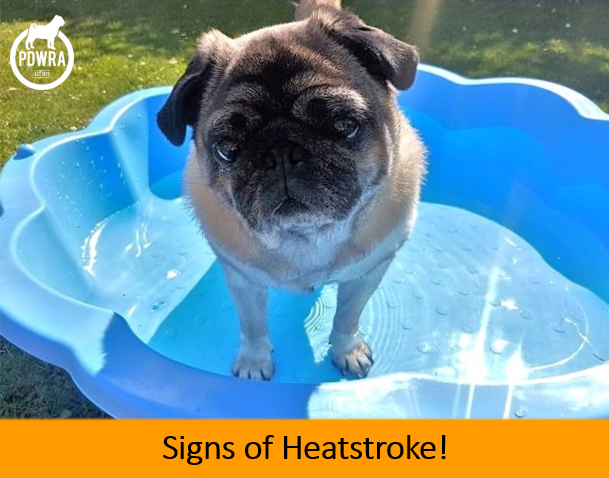
Signs of HEATSTROKE to look for, include:
-
-
- Excessive panting
- Difficulty breathing (fast, heavy, noisy)
- Increased heart rate
- Drooling / Foaming at the mouth
- Diarrhoea (may be bloody)
- Vomiting
- Weakness / Collapse
- Stupor / confusion
- Drowsy & uncoordinated
- Lethargy (low energy)
- Shaking
- Seizures
- Unconsciousness
If your pug experiences any of these symptoms, please seek the advice of your Vet immediately.
Heatstroke is more dangerous the longer it lasts, so the quicker your pug is cooled down and treated by a vet, the better their chance of a full recovery.
In an EMERGENCY:
1) Immediately move your pug to a cooler area, a cool, darkened room or into the shade
2) Cool them down straight away
- Calmly and quickly use cold water (water from the cold tap is fine) over their whole body, or use wet cloths or towels
- Be extremely careful they don’t inhale any water by keeping it away from their nose and mouth
- Offer them a drink of cold water but don’t force them to drink if they don’t want to. Wet their tongue with water instead.
- Create a breeze by opening doors and windows or turning a fan/air-conditioning on
- Put them on top of a cold wet towel.
- Don’t cover them with a wet towel or cuddle them as this will make them even hotter
3) Go to your Vet as soon as possible
- Transport them in an air-conditioned car or with the windows open (ensuring they can’t get out)
- If possible take someone with you to keep cooling them down while you travel
For more advice about heatstroke from PDSA including first-aid, please see:
https://www.pdsa.org.uk/pet-help-and-advice/pet-health-hub/conditions/heatstroke-in-dogs
******
For latest seasonal advice about hazards & tips, please see our webpage:
Seasonal Hazards for Pugs | The Pug Dog Welfare & Rescue Association

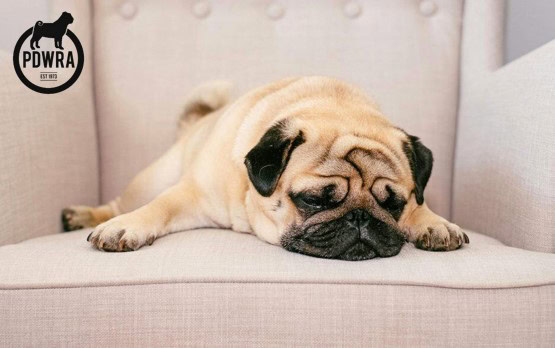
by Yasmin | 10 Jun, 2025 | Blog, Pug Health
Article by Helen McKee (MRCVS) PDWRA Vet Advisor.
How can I tell if my pet still has a good quality of life?
All pet owners want their companion to have a good life. As your pet gets older, or if they’re diagnosed with a serious illness, you may worry that they’re suffering and have more bad days than good.
It can be easy to tell if your pet has a really good quality of life – they’re still playful, active, comfortable and enjoying their food normally. Sometimes, it’ll be very noticeable that your pet is in pain and is suffering after an accident or a sudden illness. But it’s more difficult to notice problems when your pet’s quality of life gradually changes over time.
As owners, we get used to the ways our pets slow down as they age and the extra medications they might need to take. It can be difficult to tell when things start to deteriorate and, emotionally, we might not want to admit that they’re struggling.
It’s important for us to be aware of when things might be getting too much for our pet. It means we can start to prepare ourselves and ensure that our beloved friend won’t suffer.

Measuring your pet’s quality of life
Quality of life isn’t measured by just one thing; it takes into account all of the parts of your pet’s mental and physical wellbeing. This means it can be difficult to measure.
Your vet can help you measure your pet’s quality of life. But your vet only sees your pet during an appointment, and they know you are best-placed to understand how they are getting on day to day.
If their quality of life is getting worse, this doesn’t always mean that it’s time to say goodbye. It’s always best to visit the vet if you notice a change in your pet, even if they already have a diagnosis of a serious illness. There may be other medications or management techniques to help your pet. If other options are not right for your pet, then your vet can give you guidance on when it might be the time to say goodbye. It is particularly important if your pug has a terminal disease and medication cannot keep them comfortable.
You can use the pointers below to regularly check on your pet’s quality of life. It’s good to do this regularly as it can help you spot when things are starting to change.
- Are they in pain?
- Do they shake, tremble or pant, even when they’re resting?
- Do they hide away and not want to be touched or stroked?
- Does it seem to you that their pain medication has stopped working?
- Are they struggling to get around?
- Do they struggle to get up without your help?
- Are they unable to exercise, even just gently?
- Do they lie in the same place all day?
- Do they often fall over or lose their balance?
- Do they pant more than usual or seem to be struggling for breath?
- Are they eating and drinking normally?
- Have they lost interest in food, even turning down their favourite treats?
- Are they being sick or suffering from diarrhoea?
- Are they losing weight?
- Are they going to the toilet normally?
- Is your dog struggling to let you know when they need to go outside?
- Is your pet pooing and weeing where they rest?
- Can they keep themselves clean?
- Do they smell of wee or can’t keep their bum clean?
- Does their fur look duller and less healthy than it used to?
- Has the way they behave changed?
- Have they stopped greeting you when you come home?
- Are they hiding or sleeping in strange places?
- Have they stopped being interested in what’s going on around them?
- Does your pet seem unhappy or unwell in themselves?
- Do they seem confused in normal situations?
- How are you coping with looking after them?
- Do you feel overwhelmed by caring for them?
- Are you worried that you can no longer meet their needs?
- Is it becoming more stressful to give medications to them?
- Are they coping overall?
- Are they having more bad days than good days?
- Is your pet finding being medicated very stressful?
- Put yourself in your pet’s position – how do you think they would rate their quality of life?
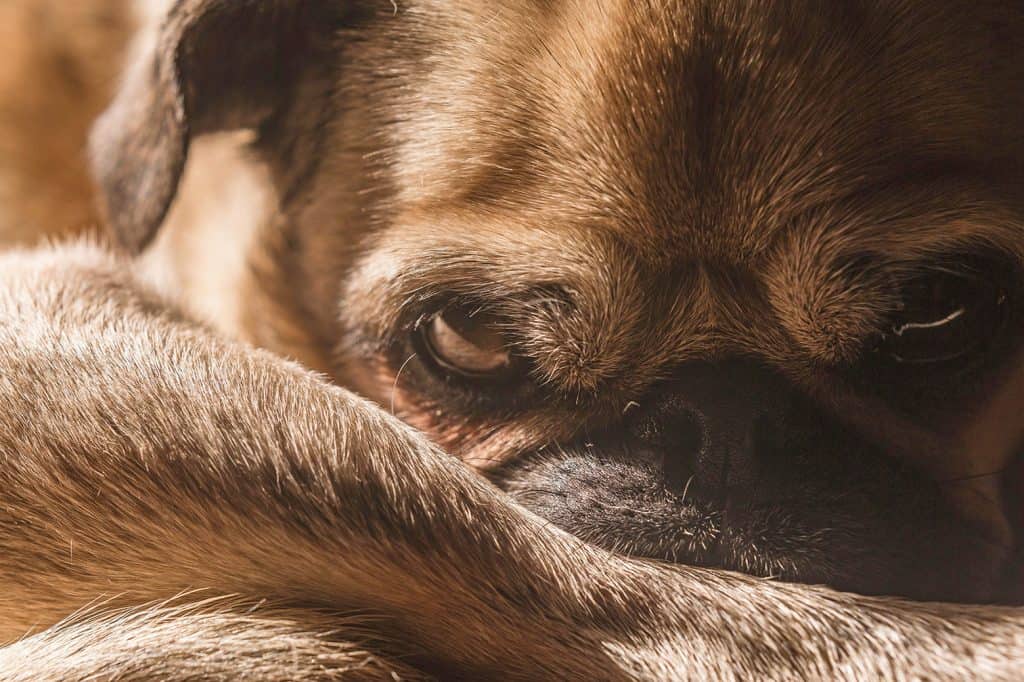
If the answers to many of these questions is yes, it’s a sign your pet is struggling. You can use these questions as a guide to see if their quality of life is changing. You may feel like you’re able to help them through the changes for a while longer or perhaps that it’s time to consider having your pet put to sleep.
You also need to consider what is important from your individual pet’s point of view. If, at their best, they love to chase their ball, then it will have greater impact on their wellbeing if they can’t do this anymore. Other pets may be fairly happy as long as they’re comfortable and not in pain, even though they can’t race around as well as before. As well as considering the questions above, make a list of your pet’s favourite activities. Think about whether your pet is able to do those activities as normal, less than normal but still acceptably, or not at all. It can help to keep a diary or a log to track changes over weeks, or even months.
What should I do next?
Now is the time to speak to your vet. Talk to them about your pet’s quality of life and what your concerns are. The vet will be able to guide and help you make the right decision.
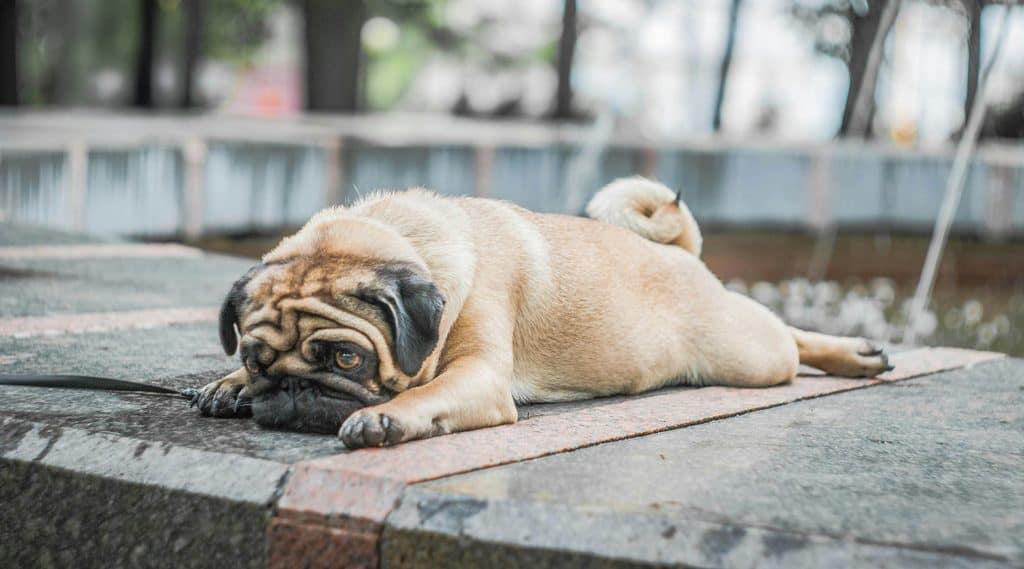
In Summary
Unfortunately, it is rare for a dog to die peacefully at home without some intervention.
We have to decide if there are more bad days than good, and also ask ourselves, are we doing the best by the pug, or are we being selfish.
For me, I feel it is a gift that we can give our beloved companions, so there is no suffering (unlike humans!) and I personally would rather say goodbye a little earlier than leave later when they could be suffering.
Wishing everyone the strength to make the difficult decision we all need to make at some stage as an owner of a pet.
Helen McKee (MRCVS)
PDWRA Vet Advisor.
*****
For other informative pug health articles, please see our web section: https://pugwelfare-rescue.org.uk/pug-health/

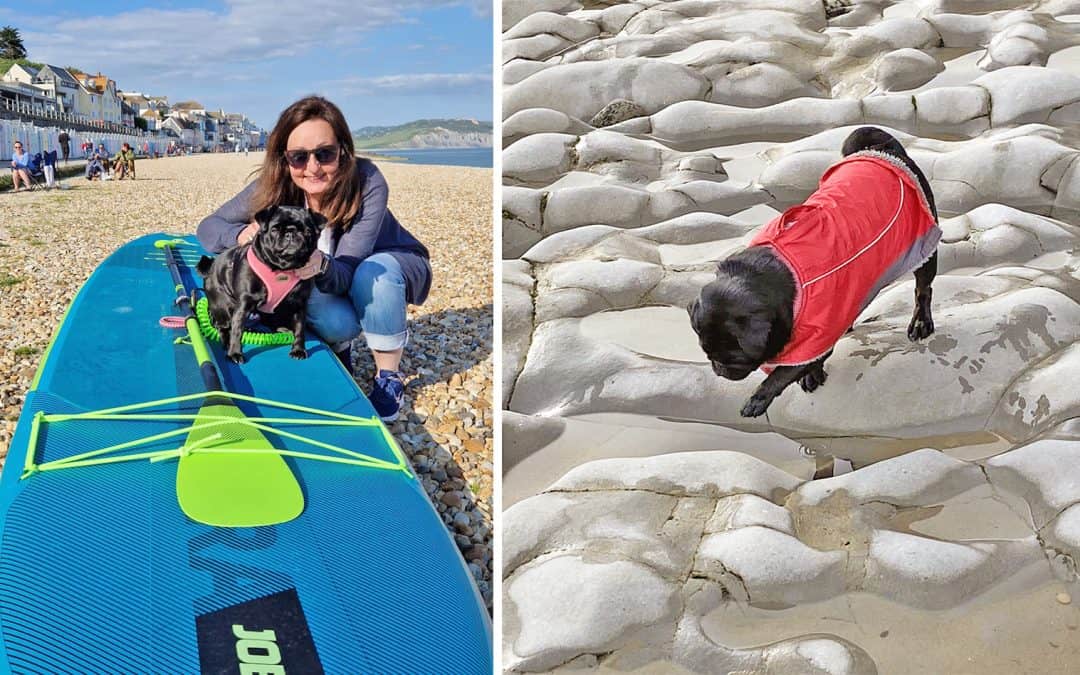
by Yasmin | 10 Jun, 2025 | Blog, Rescue Stories
Way back, I have wanted to have a dog, particularly a pug but I felt blessed to have neighbours who have a grumble and allowed us to care for them when they went away. These were great times. My partner was also very keen to have a dog, but a big one, particularly a German shepherd. After hours of discussion, we agreed that fostering was a good option for us, and a pug would be more suitable to manage. We completed the online forms to be a foster parent, and had a home check and I think at the time I was not expecting to hear anything again. But less than a fortnight later, I received a call from PDWRA asking if we could foster a little girl for 2 weeks who was about to be surrendered. Of course, we said yes, and arrangements were made between the multiple volunteers to make this happen – they really are heroes – the volunteers put their own lives on hold at a moment’s notice, for free to save pugs.
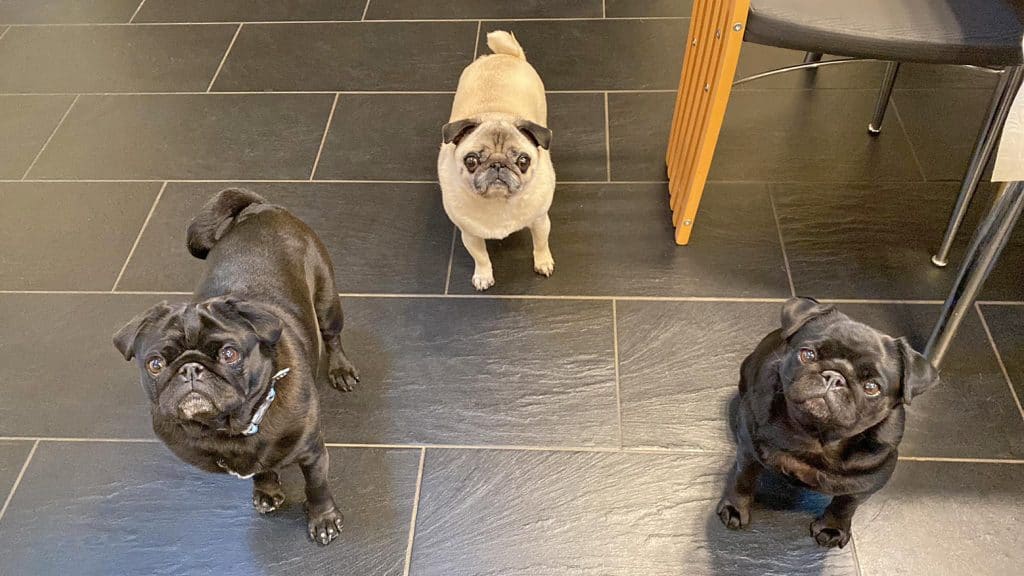
As our foster girl was coming a long way, we met halfway in a service station. The volunteers passed on the information available, and I sat in the back of the car cuddling and soothing a frightened little black pug who cried all the way home.
Once we were back home, we let her explore and she stopped crying and ate her tea. She had a little walk and was a bit more settled. When darkness fell, the howling started, so we spent the night soothing her. Luckily, nothing wrong with her appetite! After a few days, she was slowly becoming more confident, as we were too. After a week, she seemed more settled and happier and the howling stopped. She was enjoying walking with other pugs, exploring the woods, seeking new sniffs and the outdoor sunshine. I recall a particular day, she had just eaten, worn out from a walk, and she jumped on my lap whilst I was on the sofa and just sat still using me for warmth. This was the moment I realised that she could not go to another home. Arrangements were quickly made, and we formally adopted Martha. I love that we failed at fostering!
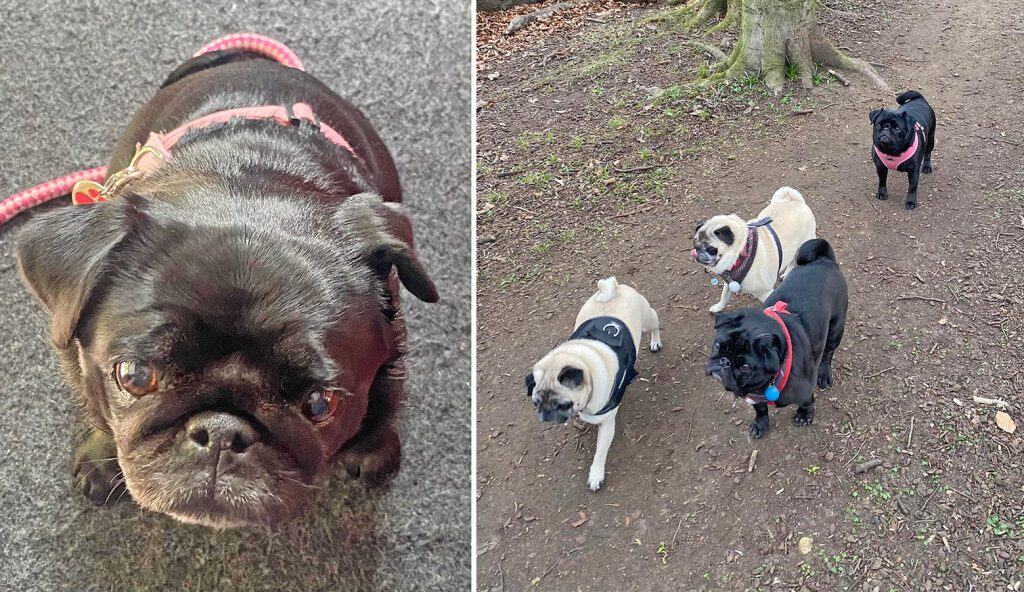
Since then, Martha has become the boss – Breakfast is 8am and dinner is 5pm and there is no deviation permitted! Carrot lunch is 12.30 and must not be forgotten. We never knew how strict a pug routine was! She has suffered from the usual pug things, BOAS surgery, eye ulcer and usual pug tummy issues, but thankfully quick to bounce back. We have adjusted to life with a full-time pug jointly enriching our lives. She comes camping with us, loves the beach and exploring. Martha loves company and lucky to be spoiled rotten by grandparents, she walks daily with the grumble in our neighbourhood and is always first to lead us into coffee shops and restaurants, where she behaves impeccably. She will do anything for treats which we do need to watch!
The PDWRA are amazing, they help change lives for many, and we remain ever grateful. I have transported other pugs and love reading about pug adventures from other fosterers and adopters. Each pug is a lovable force that deserves to live their best life.
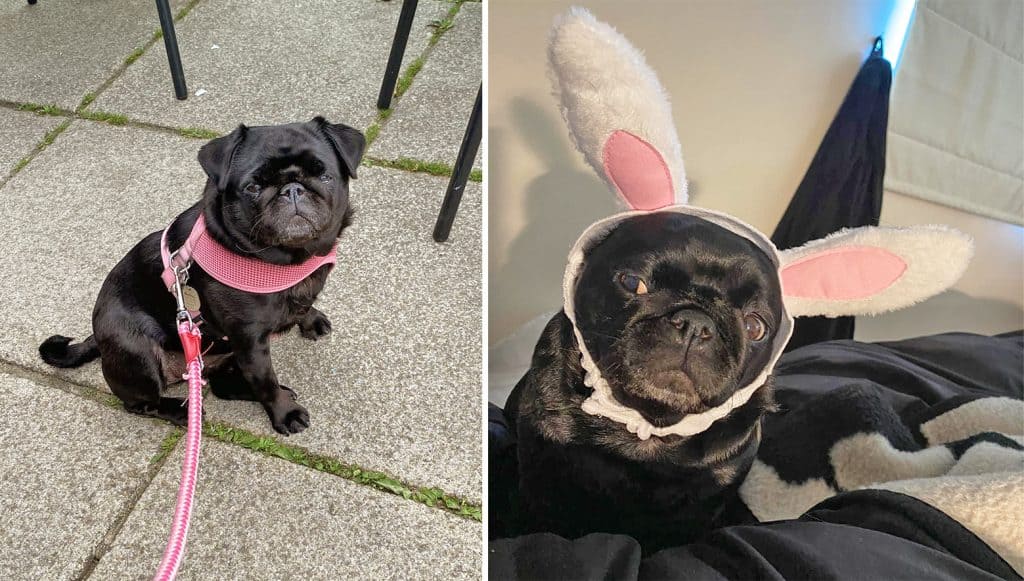
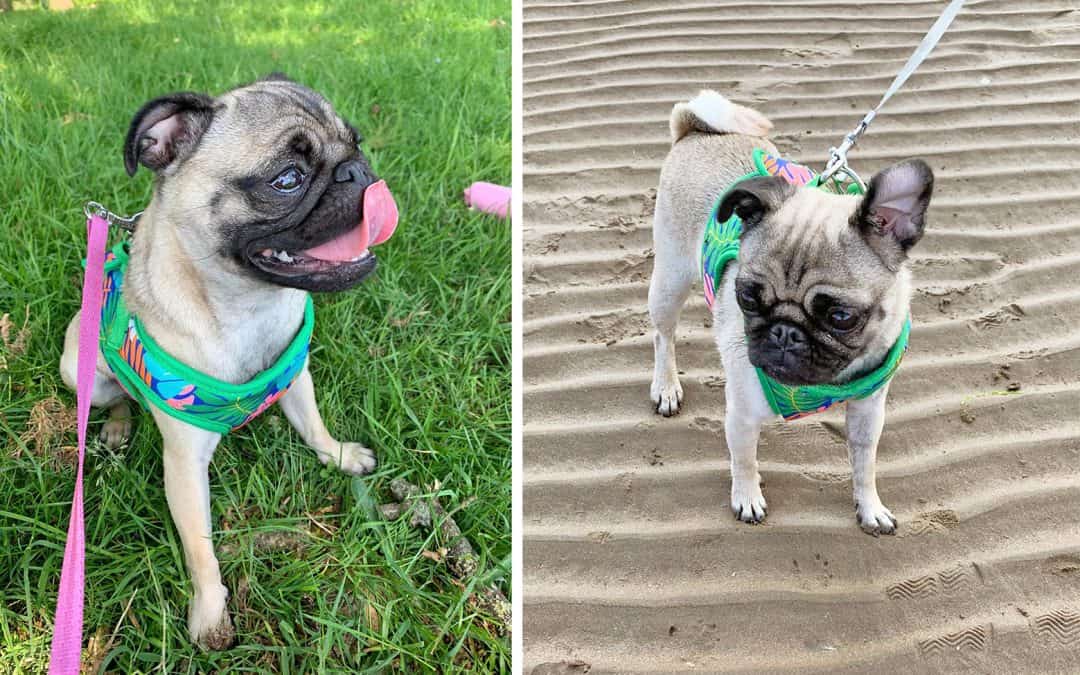
by Yasmin | 10 Jun, 2025 | Blog, Rescue Stories
Why pugs, why rescue, why the PDWRA? This for us began a long time ago, my eldest son (now 16) fell in love with pugs when he was 4 after meeting a very handsome pug on the Isle of Wight called Dave. A love affair began, which never dwindled, however we could never own a pug because my husband was allergic to pet hair. Fast forward many years and a divorce later, also back on the Isle of Wight, a pug was on holiday in the caravan next to us !! It is fair to say that my son did not relent in his persistence over owing a pug & fate has a funny way sometimes. When we returned home, the research began. I knew I wanted to rescue a dog, there was no way I was buying a puppy when so many dogs need a forever home and the most important part was that whoever came our way, their name had to be Dave.
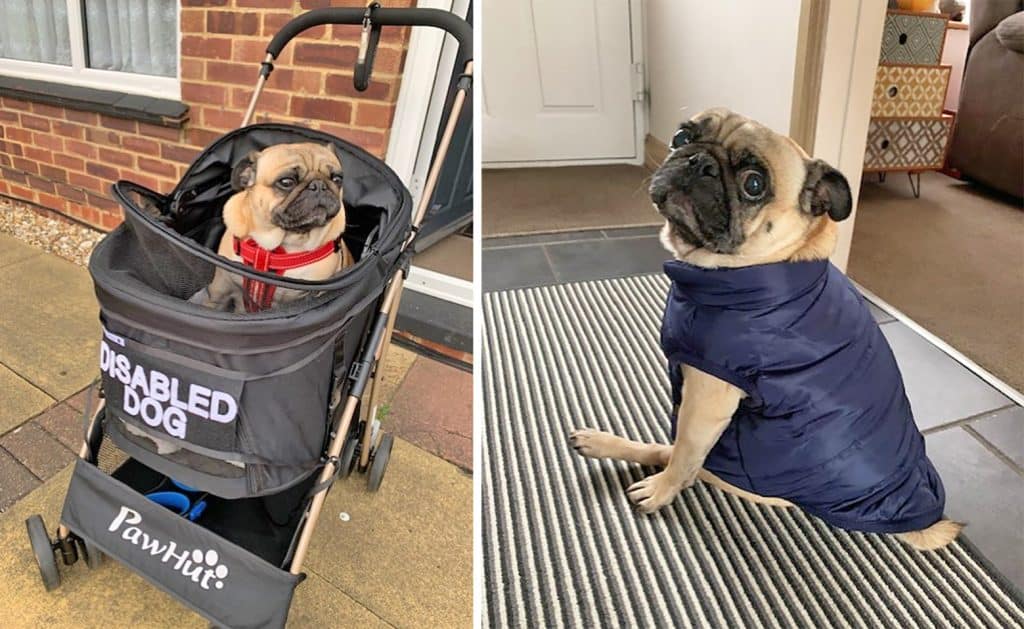
I researched local pug rescue teams, found the PDWRA and applied. Thankfully we passed all the interviews and were placed on the adoption register. A call came through sometime later asking if we would consider a lovely boy with wonky legs and with a resounding ‘yes’ from our little family of 3 Dave became ours.
I knew nothing about pugs, a lot about dogs but not pugs. I have totally fallen in love with their wacky little characters, their need to be with you, the fact that they are as excited to see you if you have gone into the garden and come straight back in or if you have popped off to the shops, the fact that they have to be on your lap if you are sitting down.
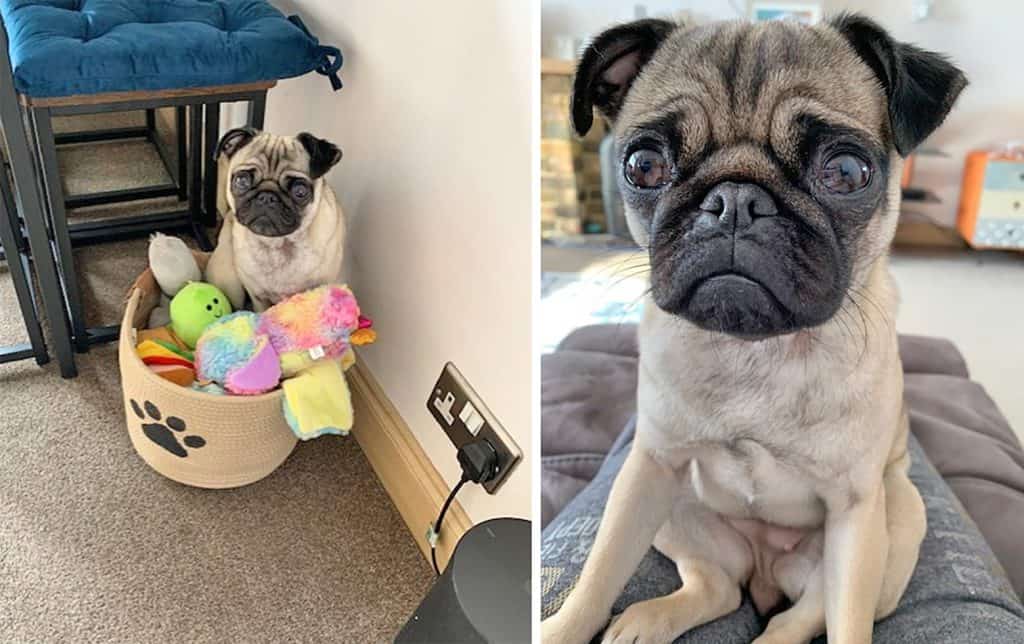
We were smitten! We utterly adored Dave and his existence in our lives changed a lot of things for the better. Sadly, he became very ill, very quickly, a year after we adopted him and was put to sleep in December of 2023. I have known heartbreak but nothing on this level, so whilst scrolling the PDWRA Facebook page in the following January, getting my fix of puggy beauties, I saw a post asking if anyone could give a cute, tiny little innocent looking lady a home! Cue Sandra ….. a sign from Dave I think! She is a pint-sized hurricane of a dog…
We adopted our chaotic 4kg bundle of energy, also known as Sandra, in February 2024 and have not looked back. She is hilarious, stubborn and totally adorable, she absolutely has us wrapped around her little paws. She is our world and owns us, it is not the other way around and our lives are infinitely better with her in charge of our house.
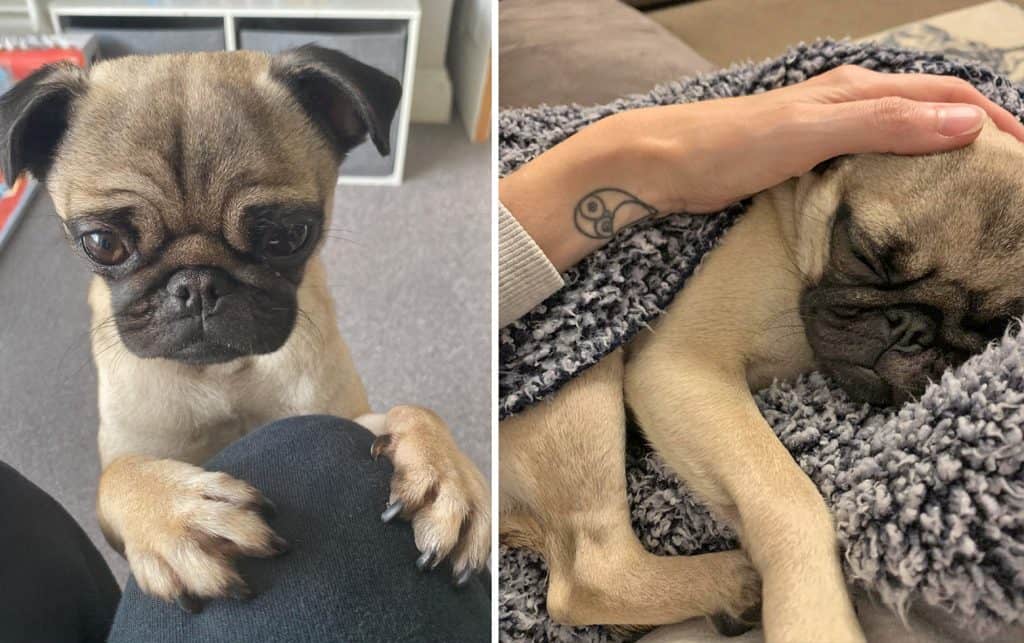
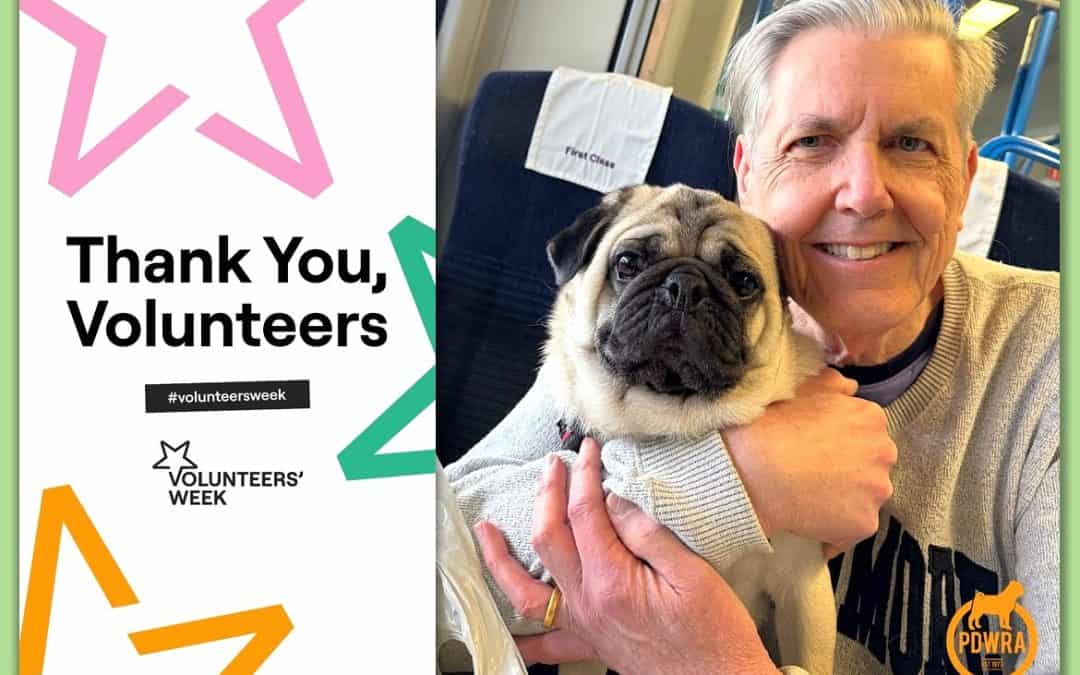
by Yasmin | 5 Jun, 2025 | Blog, Rescue Stories, Volunteering
Finding the right match of pug to adopter can mean literally going the extra mile for the pug in question, and this was the case for Wilfred.
PDWRA have a network of Volunteers who generously give up their time to transport pugs for us, collecting from owners, being part of a transport run, or taking to waiting homes.
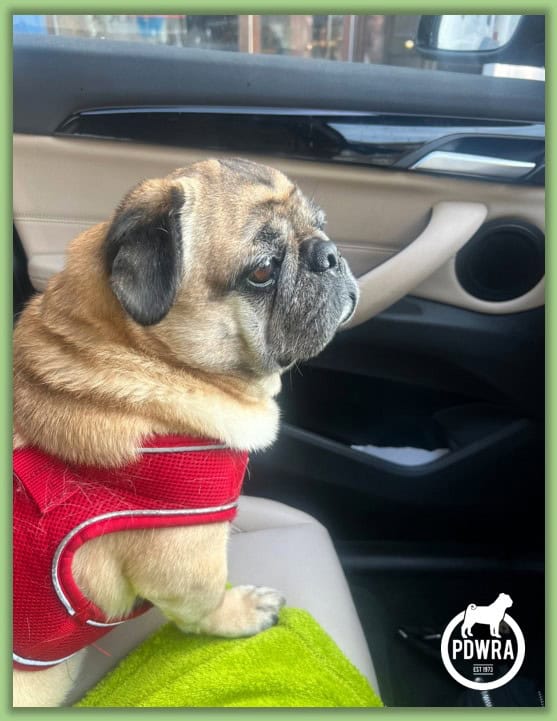
In Wilfred’s case he needed to join his adopter near the South Coast, so getting him from his Foster Carer in the North, all the way there, was going to be a challenge!
We already had another pug, Michael who was due to be rehomed further along the South coast to Wilfred’s destination. His journey was already arranged and he was due to travel by train from London. So it made sense for both pugs to travel together, and our Volunteers stepped up to get Wilfred to London in good time to catch his train.
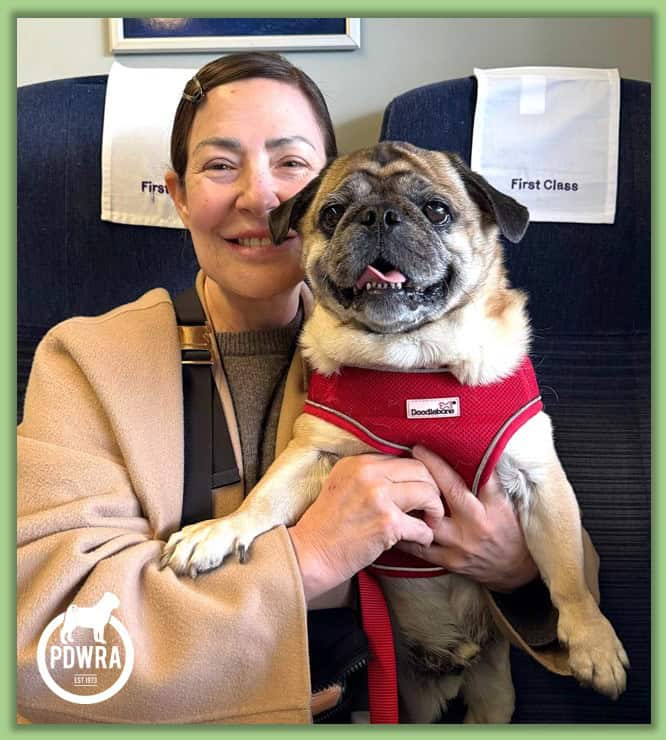
Both Wilfred and Michael travelled in style down to Brighton, attended by Michael’s Foster Carers, and thoroughly enjoyed the experience.
It’s not usual for pugs to travel by train and we don’t insist on first class ! However, we do welcome those who are able to give up some time on the odd occasion to drive a pug, or pugs, to their destinations.
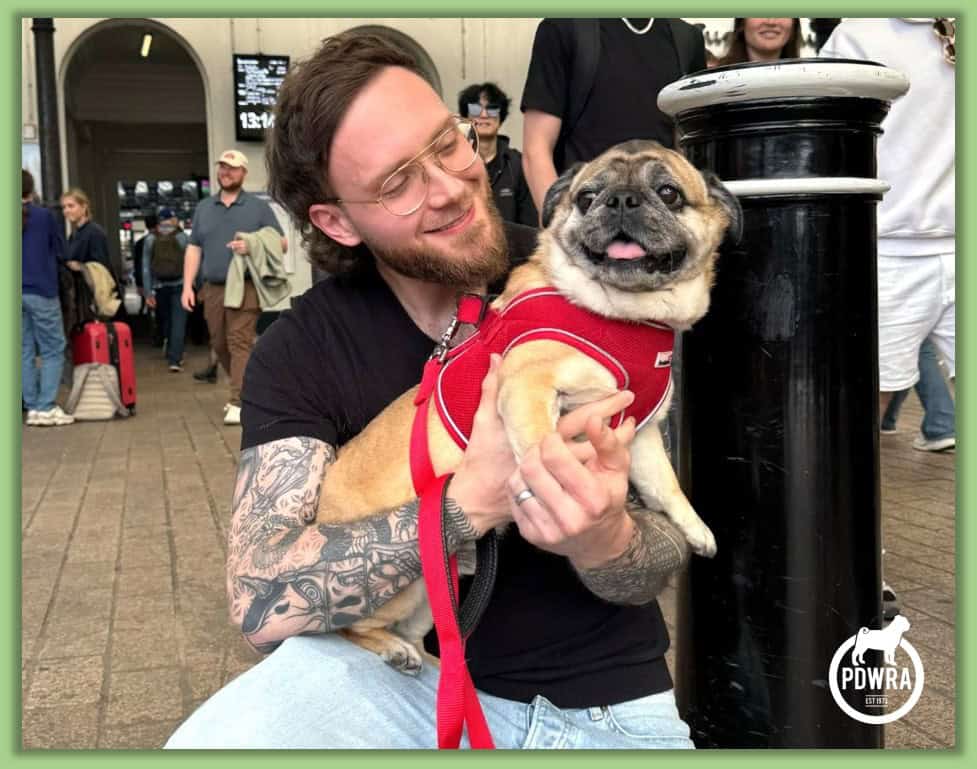
At the Station they were met by their respective adopters who were overjoyed to make the acquaintance of the new members of their families. Everyone was beaming!
It is such a rewarding way to participate, albeit in a short but important part of a pug’s life.
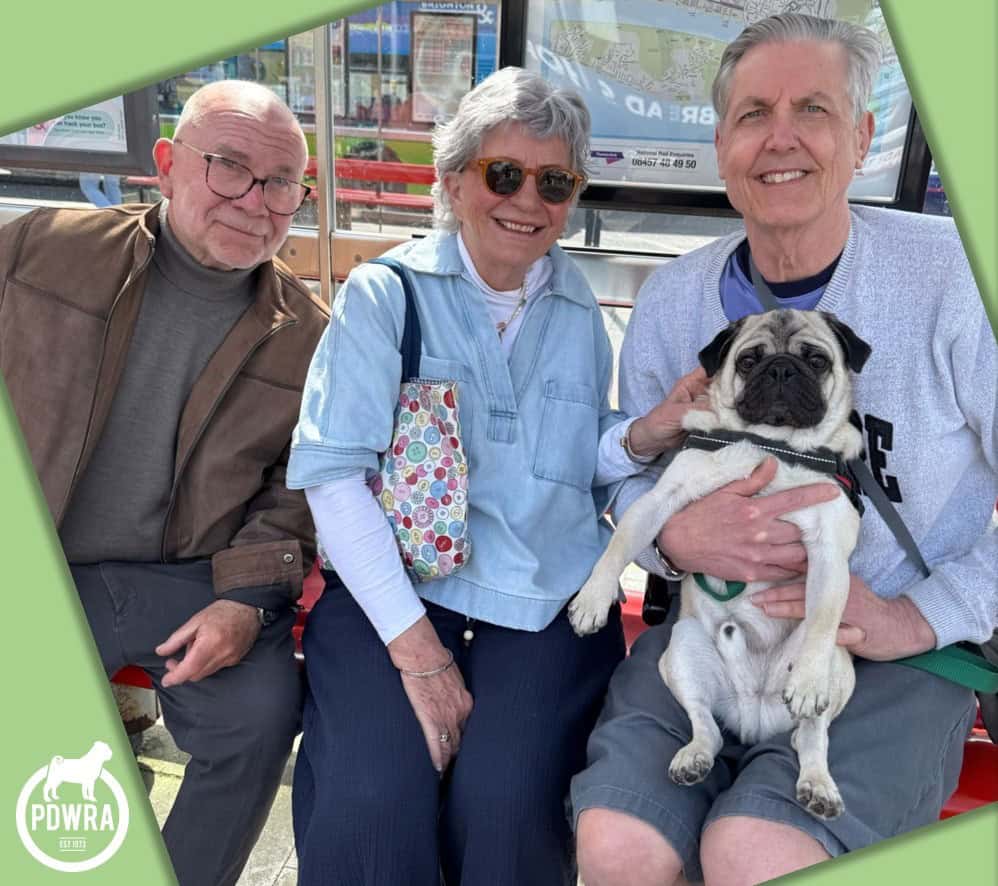
******
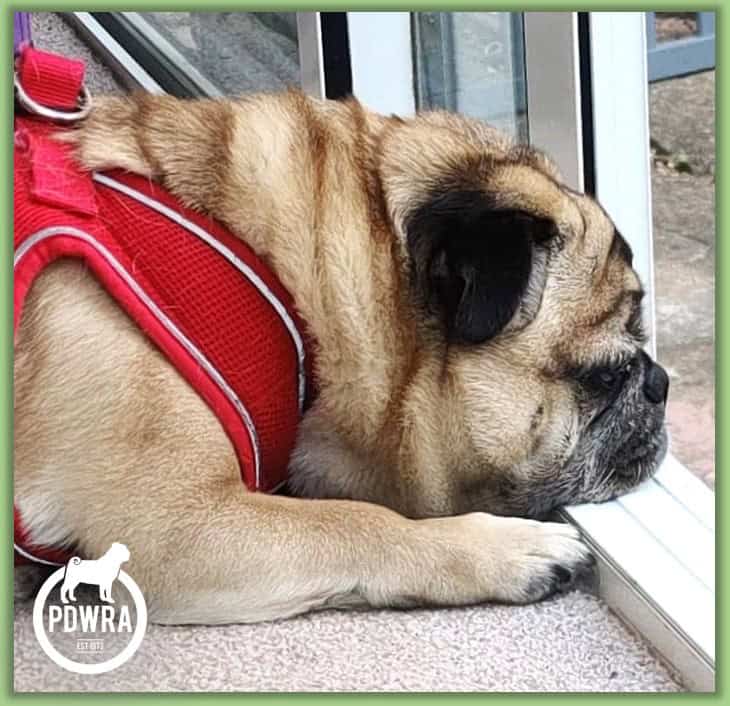
Wilfred, at the end of a long day & just the beginning of his new adventure!
******
Volunteers are welcome in all parts of the country, and it may be that the trip could be incorporated into a planned visit for business or a family occasion. One of our Volunteers even dropped a pug off to its Forever Home on her way to a funeral !
We are grateful for the time freely given by our Volunteer transporters; pugs could not join their respective fosterers or adopters without their support.
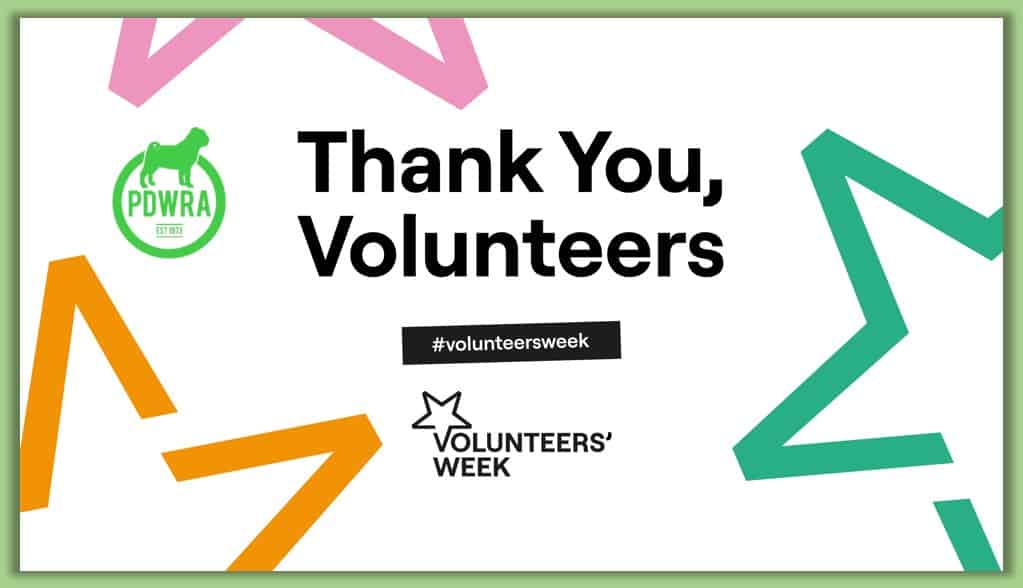
If you are able to help a pug along its life journey by transporting between homes, sometimes in a convoy for longer journeys, please complete the online application form here:
Volunteering for PDWRA | The Pug Dog Welfare & Rescue Association
******

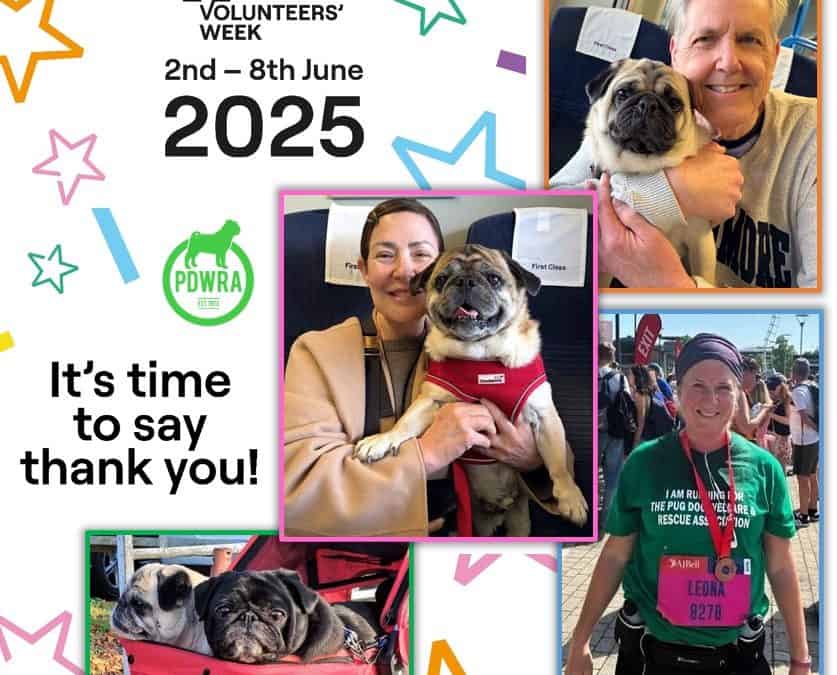
by Yasmin | 4 Jun, 2025 | Blog, News, Volunteering, Fundraising
💖This week is National Volunteers’ Week, and the perfect time for PDWRA to celebrate its ongoing gratitude to ALL Volunteers! 💖
🤗 THANK YOU ALL! 🤗

We could not help Pugs in Need without the voluntary contributions each & everyone makes with their skills, experience & time. Our costs are covered solely by public donations & fundraising!
Volunteers contribute to all stages that enable rehoming, from Trustees in Management to the regional rehoming co-ordinators (Voluntary Area Co-ordinators – VACs), who facilitate local pug rescue/surrenders, health & welfare assessments, rehabilitation where needed, and organise the onward placements to the pugs’ best-suited homes.
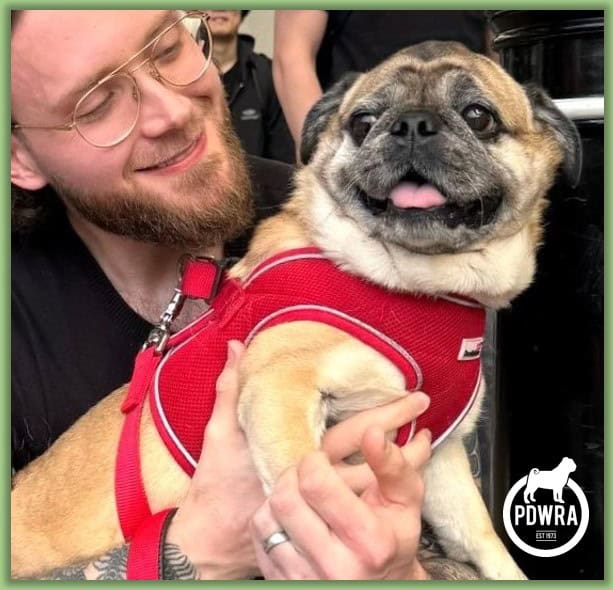
This is where regional, local, Home-checkers & Transporters are essential, volunteering their time to achieve the goal of rehoming Pugs in Need safely and securely.
Additionally, to support these operations, are the dedicated small teams for the PDWRA Facebook Mega Auction group’s Fundraising, plus Communications, managing PDWRA’s Website and Social Media, keeping everyone informed & updated.
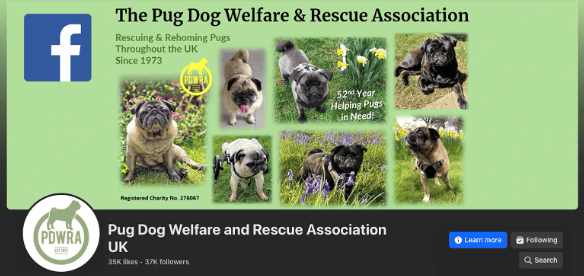
******
Here’s a recent, wonderful example of Volunteers going the extra mile to get pugs along their life’s journey to their Forever Homes. In this case, Wilfred & Michael reaching their respective Forever Homes.

Read the full story with more photographs, here: https://pugwelfare-rescue.org.uk/thank-you-pdwra-volunteers-transporters/
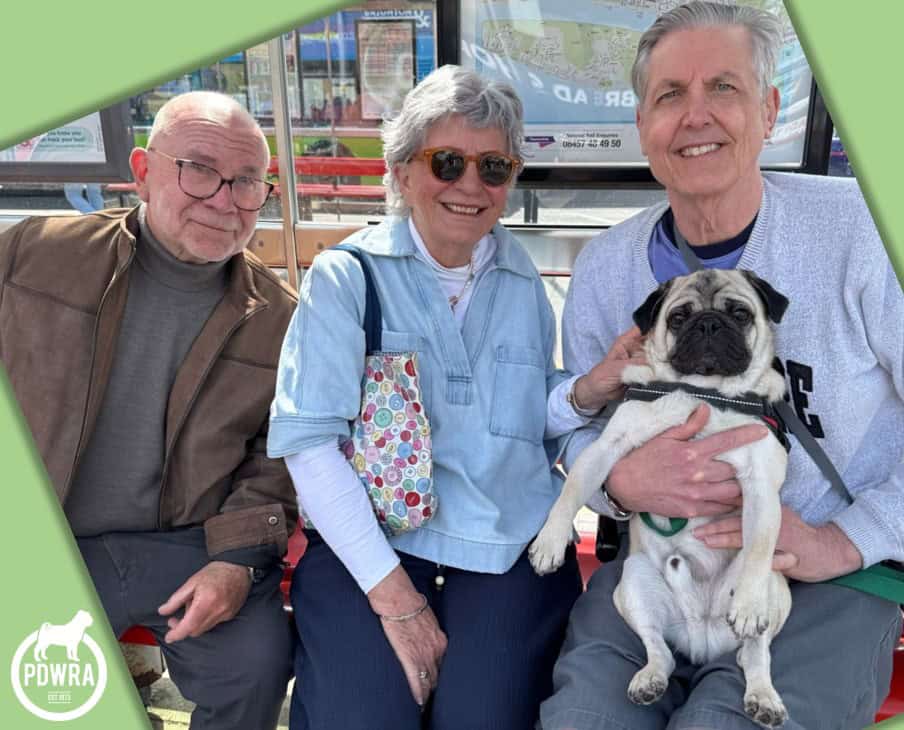
******
Volunteers are welcome from all parts of the country.
We are grateful for the time freely given by our Volunteer Transporters, as well as Home-Checkers; Pugs could not join their respective Fosterers or Adopters without them!
To find out more about Volunteering to Transport or to Home-check or Foster, please see our webpage: https://pugwelfare-rescue.org.uk/volunteering-for-pdwra/

For other dedicated Voluntary roles to consider. See our Vacancies at: https://pugwelfare-rescue.org.uk/volunteer-opportunities-at-pdwra/

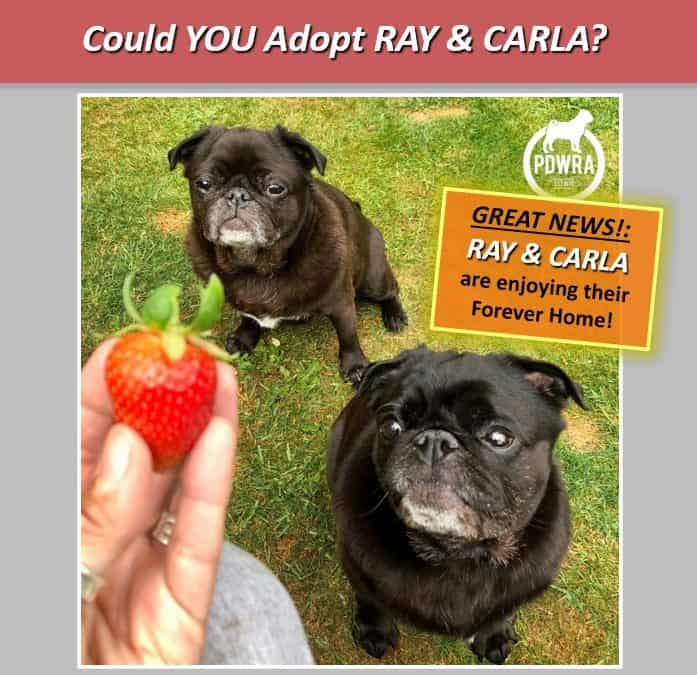
by Yasmin | 2 Jun, 2025 | Pug Home Appeal, Blog, Rescue Stories
👏 * GREAT NEWS UPDATE: Ray & Carla have found their Perfect Forever Home, together of course! * 👏
**********
RAYMOND (RAY) & CARLA.
This Brother and Sister pair, are 8 years old and very devoted to each other. Ray more so than Carla. He’s a sensitive soul and uneasy if she’s not around.
Both were quite lively on first arrival with their fosterer but have calmed down now they are in a routine and regularly walked.
Carla is a cuddly affectionate pug and loves the company of humans. Happy and calm around other dogs and accepting of cats. She is friendly and inquisitive on meeting people, though not tested on children.
Carla is to undergo surgery to improve her breathing. Once recovered, she will be able to enjoy life to the full. Both are neutered.
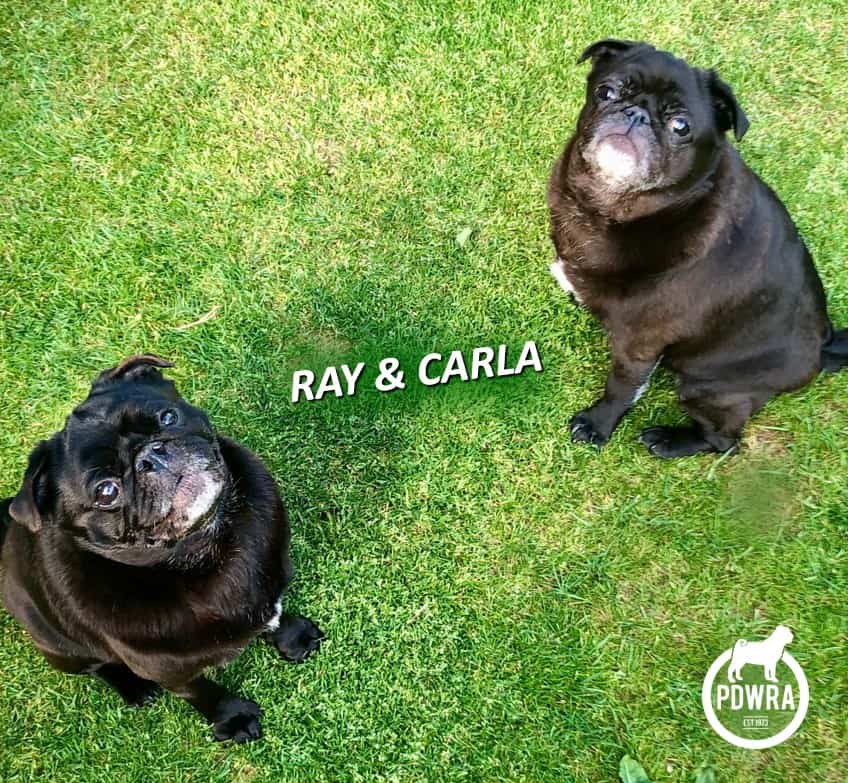
Ray is a gentle pug who loves to be stroked, he can suffer from anxiety and is at his happiest in the company of humans and with Carla by his side. Almost totally blind in one eye, he has adapted extremely well and this does not hinder his ability to enjoy the world around him.
He needs regular application of eye drops to ensure the eye is properly lubricated. Ray’s very sociable and gentle with other dogs, he can be friendly but rather shy on first meeting new people.
He gets on well with cats but will try to steal their food!
Ray prefers to walk in more peaceful settings away from traffic noise.
Both will thrive in a peaceful and calm household with love and affection. They do suffer with separation anxiety which will need to be worked on. A home with children over 10 years is advised.
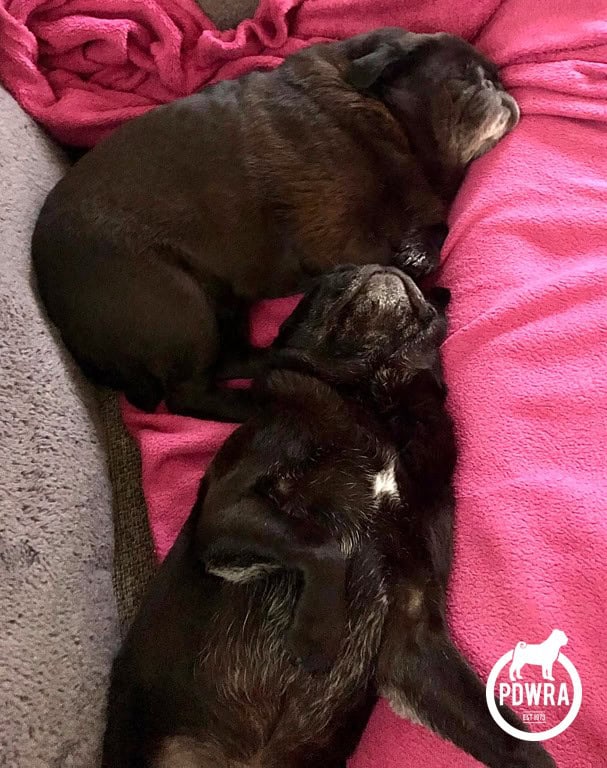
Please also ensure you have read PDWRA’s Guidelines & Conditions for Adopting, at: https://pugwelfare-rescue.org.uk/adopting-a-pug/
If you have any specific questions about Ray & Carla, or your application for them, please email Jackie at: se@nullpugwelfare-rescue.org.uk
Afterwards, do check your email spam/junk or deleted folders, in case any new mails from us aren’t recognised as safe-senders.
** We offer A £100 discount (£50 per pug), when adopting a Bonded-Pair of Pugs! **
Thank you!
******
To see the difference adoption can make to your life and theirs, see some of our heart-warming Rescue & Adoption Stories for Bonded-Pairs at:
https://pugwelfare-rescue.org.uk/perfect-pairs/

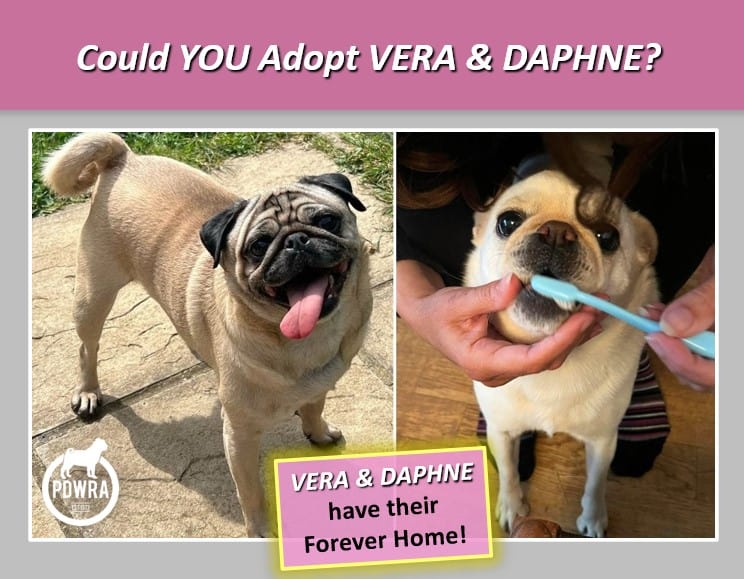
by Yasmin | 2 Jun, 2025 | Pug Home Appeal, Blog, Rescue Stories
👏 ** HAPPY NEWS UPDATE: Daphne & Vera have their Perfect Home Together! ** 👏
*******
DAPHNE & VERA
Five years old, and both spayed, Daphne and Vera are a devoted bonded-pair of pugs.
Vera is the more outgoing of the two, Daphne prefers to just chill out with her humans.
Both are in good health with Daphne recovering from recent dental surgery. She will be back to normal by the time they have their Forever Home to move to.
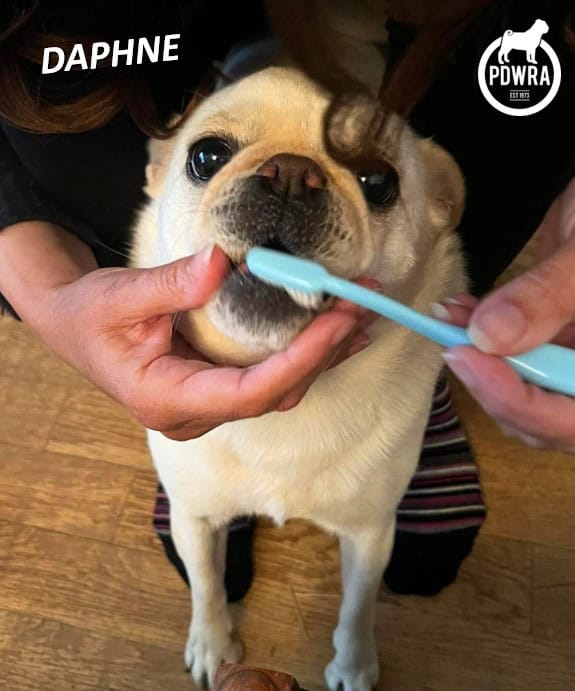
Daphne has a sweet, friendly nature, very well behaved on and off the lead. She is very calm when meeting children and is happy for them to stroke her gently. She can be startled by loud noises though, in and outside the home.
She loves her walks but you must allow for plenty of sniffing time, as she likes to take her time!
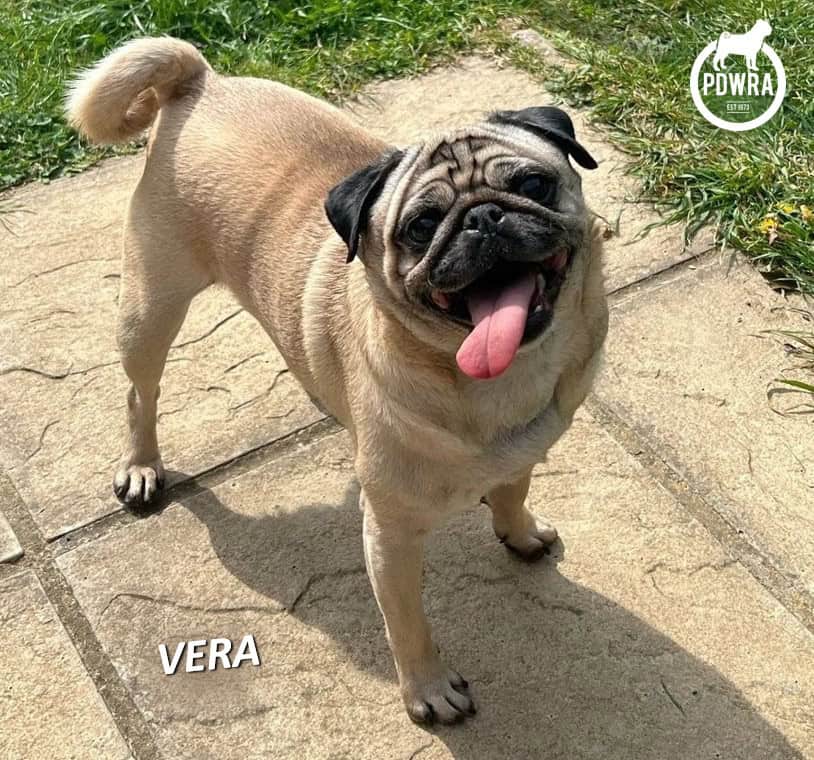
Vera is not so quick to trust people, she likes to get to know them. Give her time and space and she will make her own choices.
She is not happy being approached by strangers trying to pet her, and for this reason, care should be taken when out walking as she suffers from fear aggression and may nip the unwary. This may be partly due to a slight sight impairment as she can also be taken by surprise in dim light.
Toys are her absolute joy and she will play all day.
Both are happy living with other dogs and cats, but would be better suited with children over 10 years who can respect Vera’s boundaries.
Please also ensure you have read PDWRA’s Guidelines & Conditions for Adopting, at: https://pugwelfare-rescue.org.uk/adopting-a-pug/
If you have any specific questions about Daphne & Vera or your application, please email Jackie at: se@nullpugwelfare-rescue.org.uk
Afterwards, do check your email spam/junk or deleted folders, in case any new mails from us aren’t recognised as safe-senders.
** We offer A £100 discount (£50 per pug), when adopting a Bonded-Pair of Pugs! **
Thank you!
******
To see the difference adoption can make to your life and theirs, see some of our heart-warming Rescue & Adoption Stories for Bonded-Pairs at:
https://pugwelfare-rescue.org.uk/perfect-pairs/

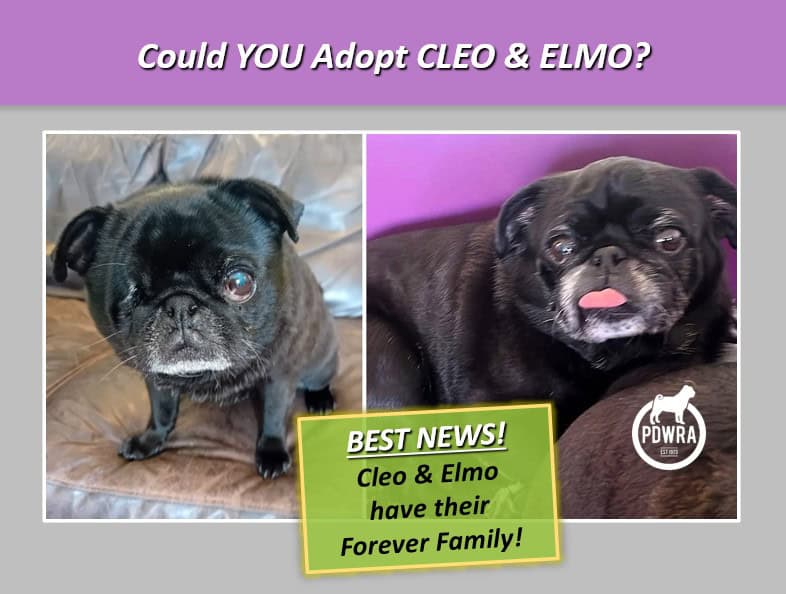
by Yasmin | 2 Jun, 2025 | Pug Home Appeal, Blog, Rescue Stories
👏 ** WONDERFUL NEWS UPDATE: Cleo & Elmo have already found their Perfect forever Home! ** 👏
**********
ORIGINAL APPEAL:
Cleo and Elmo are 8 year old siblings, super-bonded to each other.
They are used to living with other dogs but are just as happy in each other’s company. They are both neutered.
Cleo has one eye, the other must be kept lubricated to ensure it remains healthy. She is easy going and gets on with everyone, the more confident of the pair. She has had surgery on both hind legs for luxating patella but this does not hinder her mobility. Care should be taken however not to over walk her beyond her comfort zone.
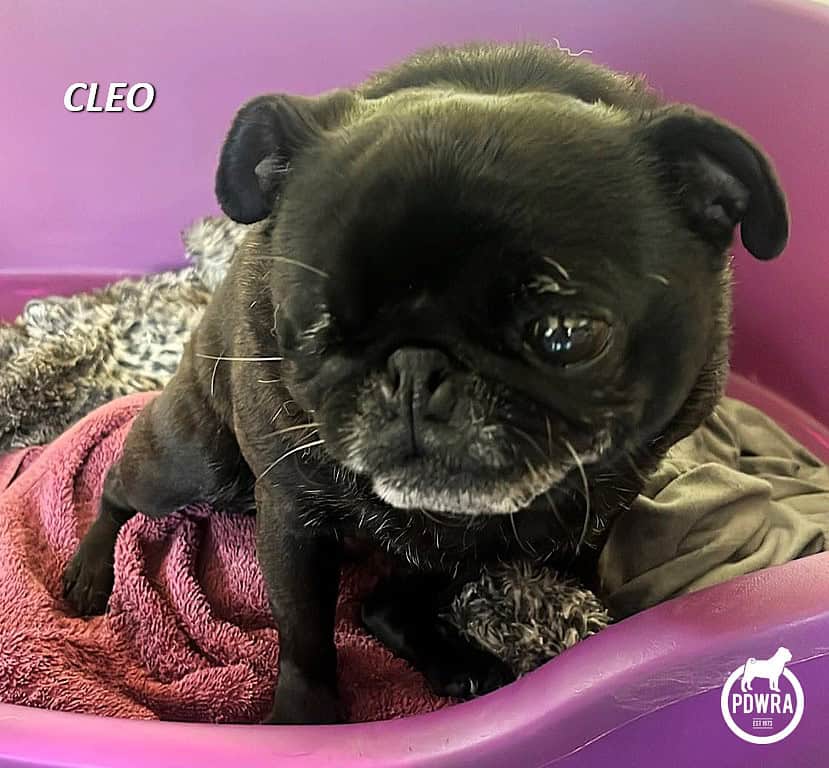
Elmo is more dependant on Cleo and does not like to be parted from her. He’s easy going and very calm but is anxious if not within sight of Cleo.
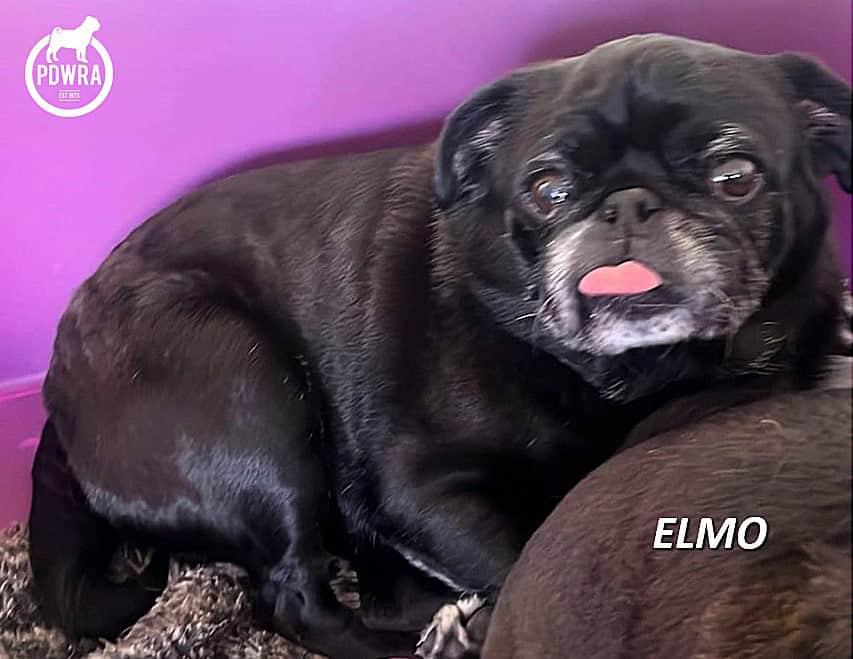
Both love to sit with their humans and enjoy cuddles on the sofa. They mix well with other dogs and are used to children. Not tested on cats. An easy-going pair who should fit in with most households providing they have plenty of opportunities for cuddles, and are walked within their capabilities.
These charming siblings will bring a lot of love and devoted companionship to anyone’s home.
Please also ensure you have also read PDWRA’s Guidelines & Conditions for Adopting, at: https://pugwelfare-rescue.org.uk/adopting-a-pug/
** Don’t Forget – We offer A £100 discount (£50 per pug), when adopting a Bonded-Pair of Pugs! **
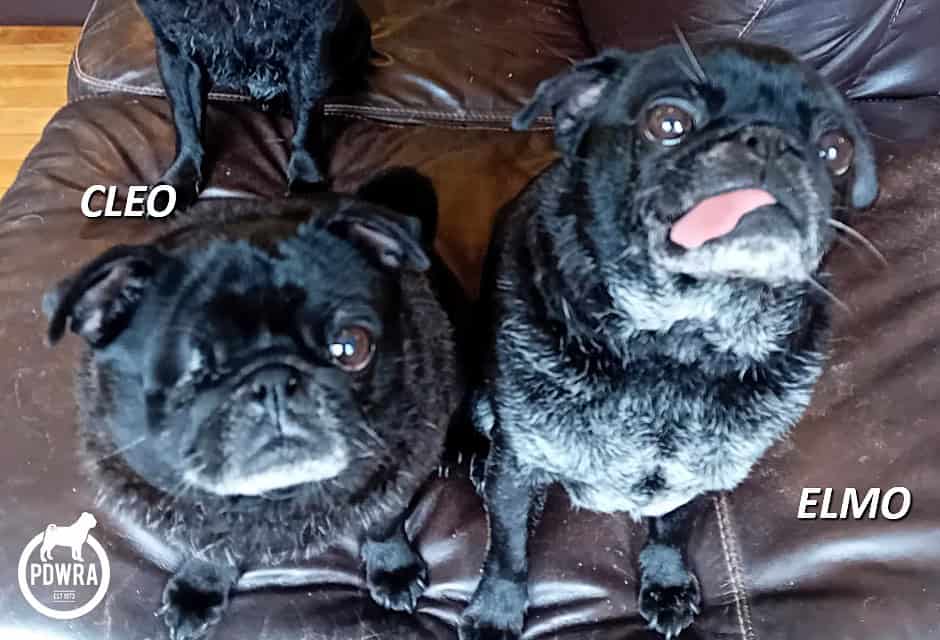
Thank you!
******
To see the difference adoption can make to your life and theirs, see some of our heart-warming Rescue & Adoption Stories for Bonded-Pairs at:
https://pugwelfare-rescue.org.uk/perfect-pairs/



































































